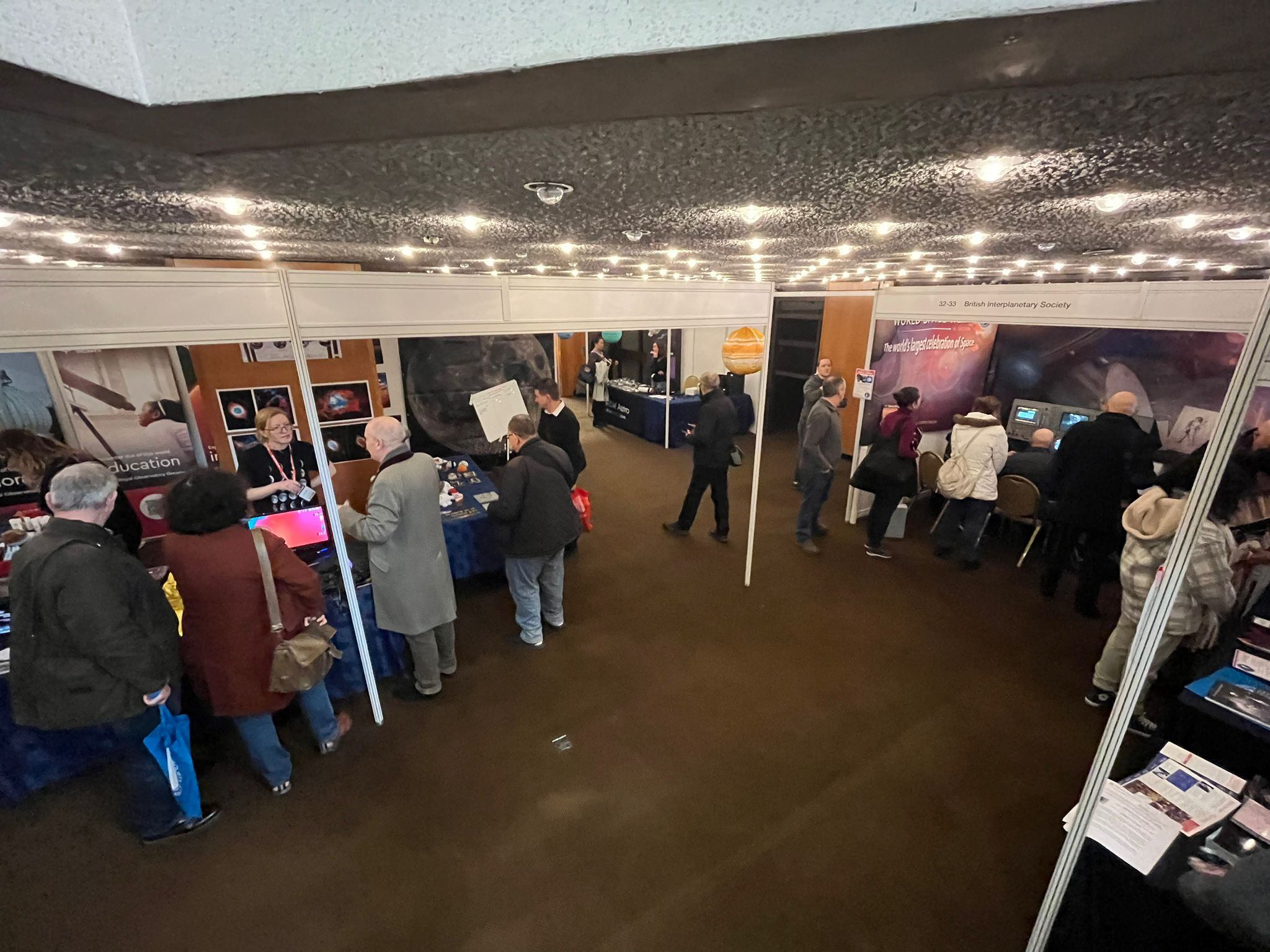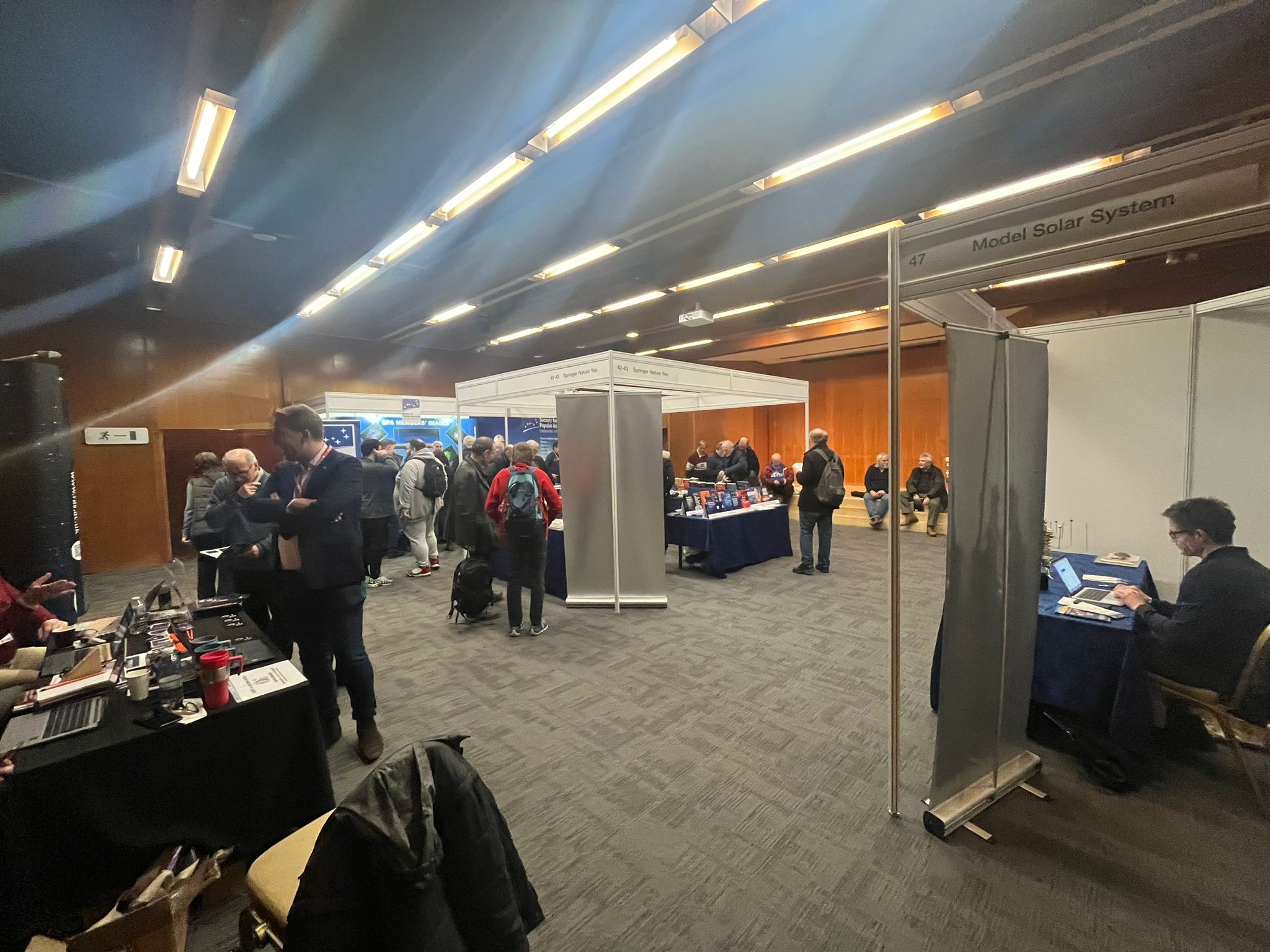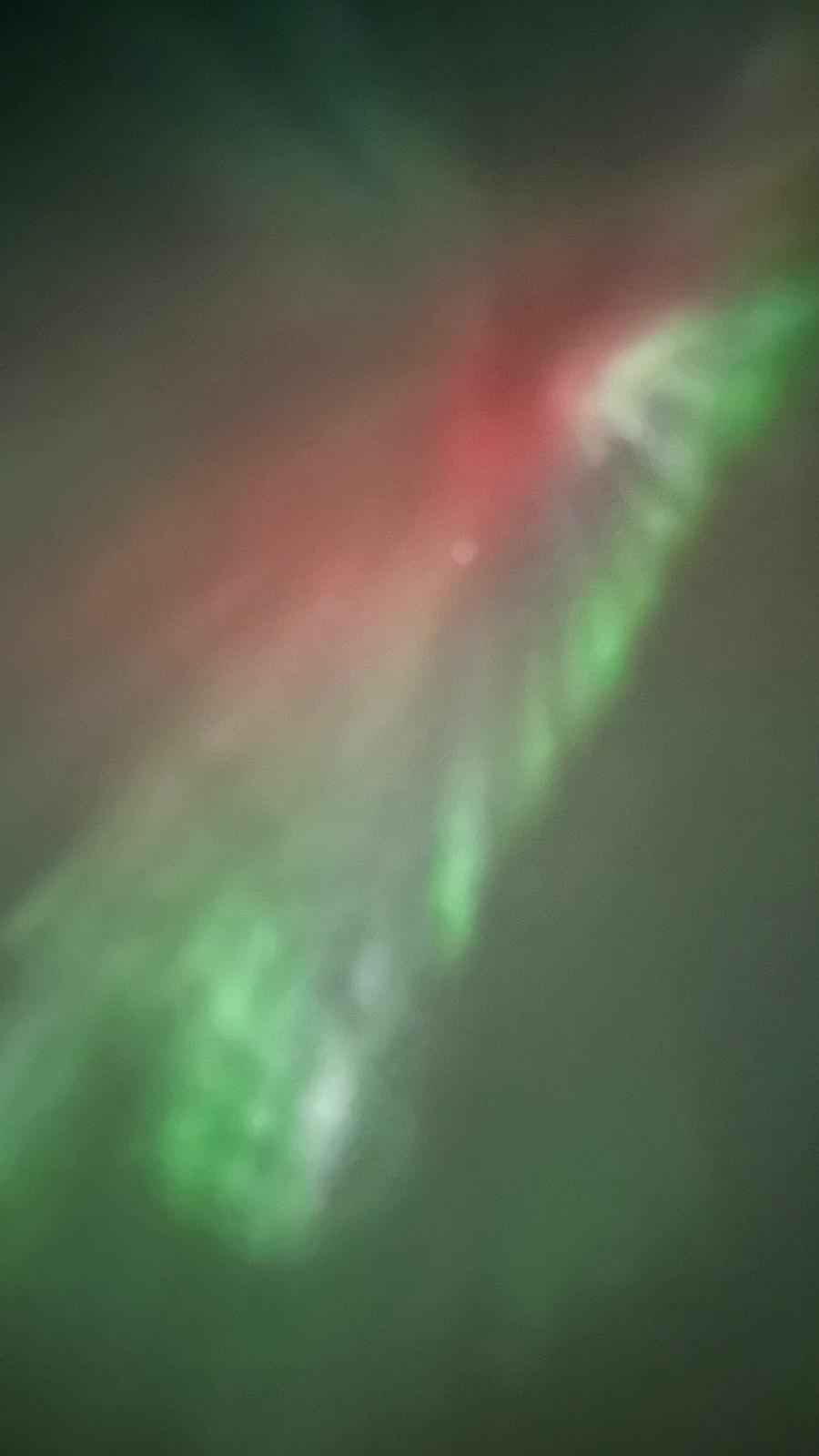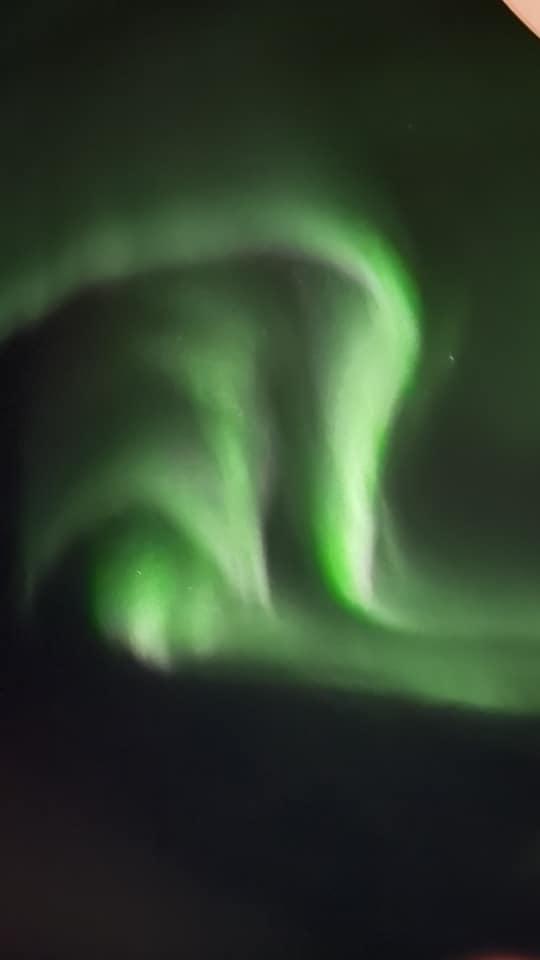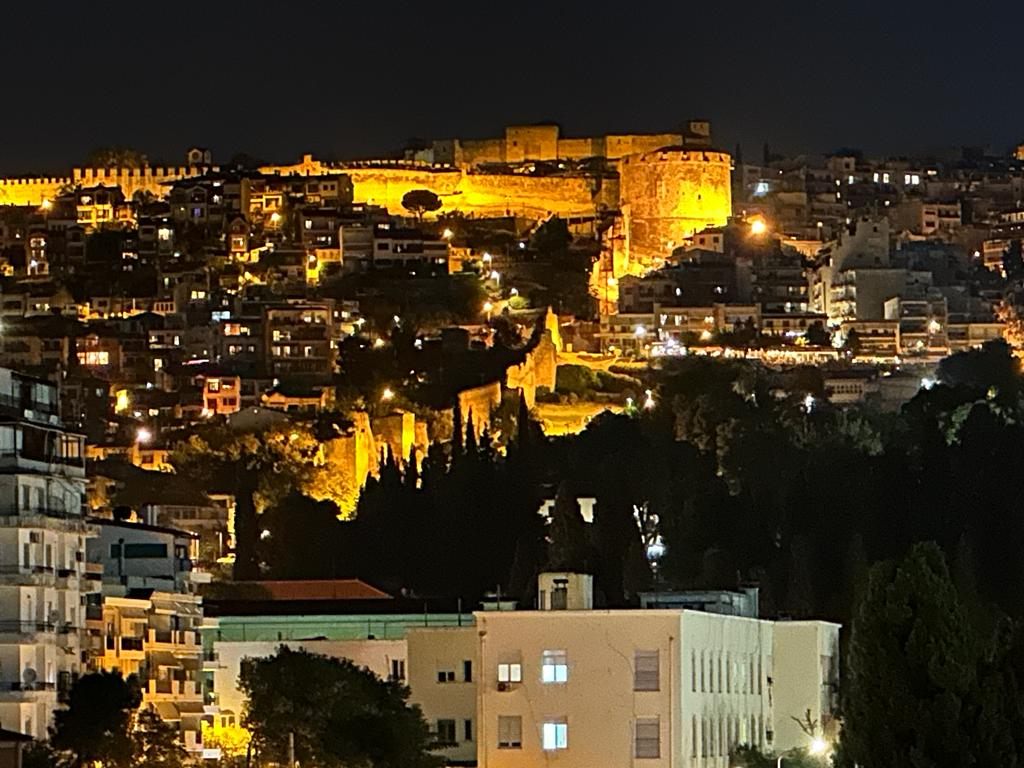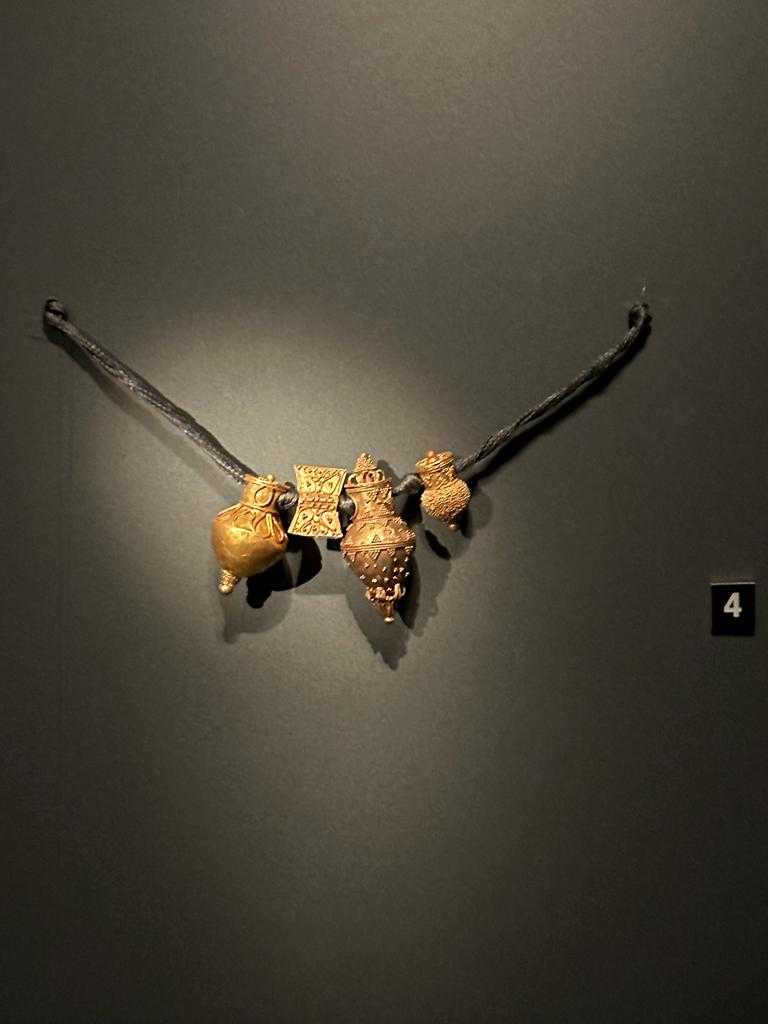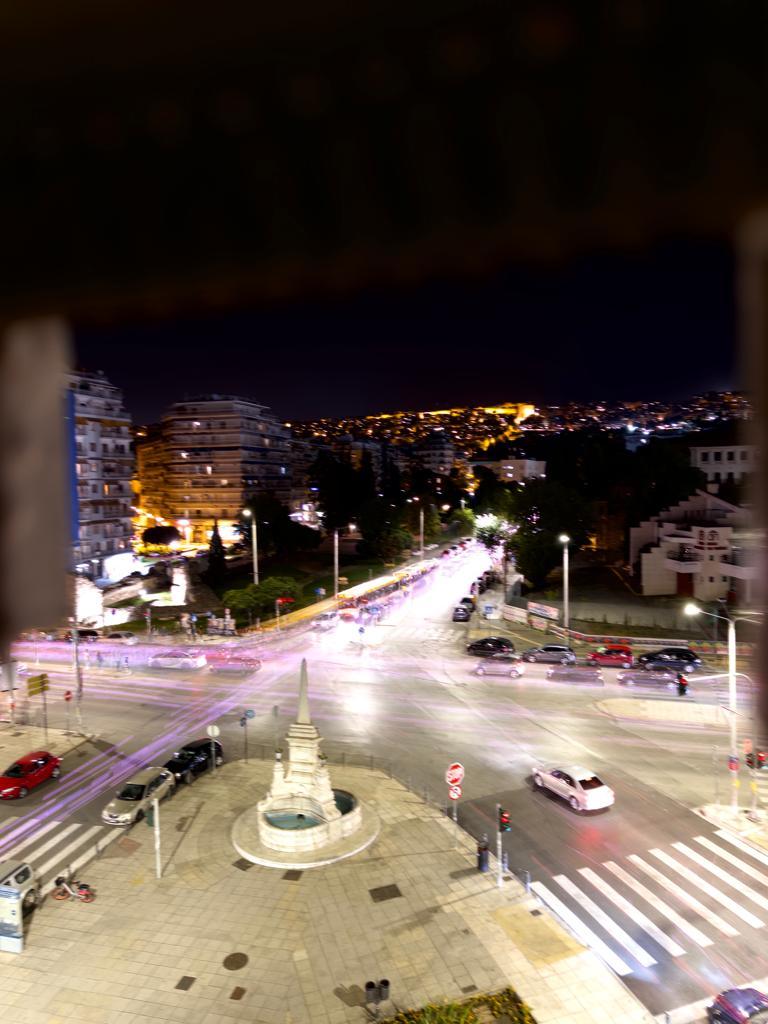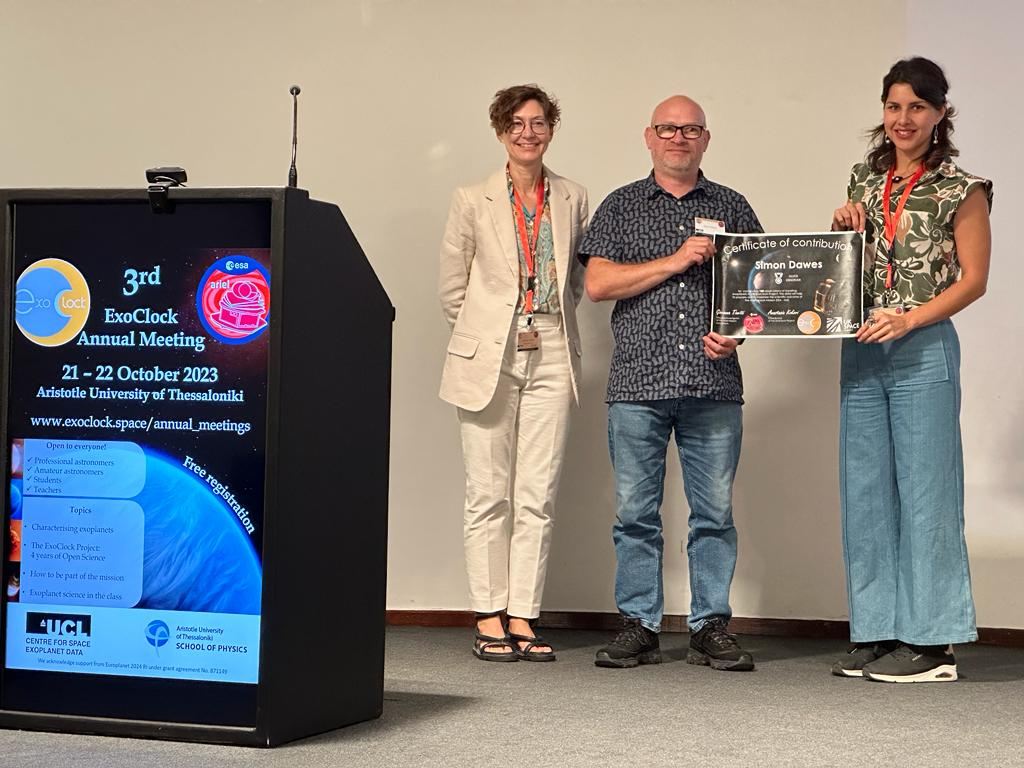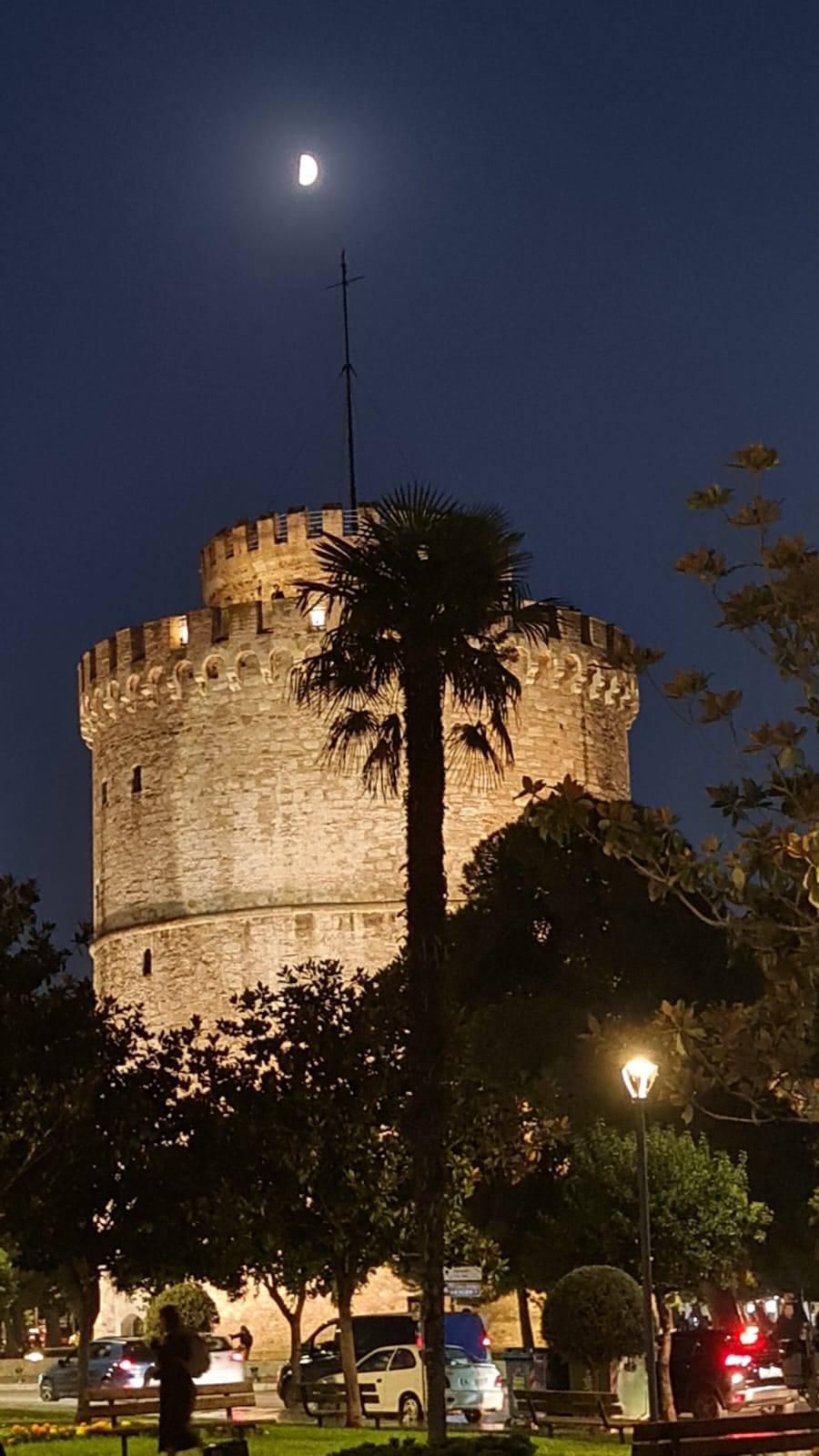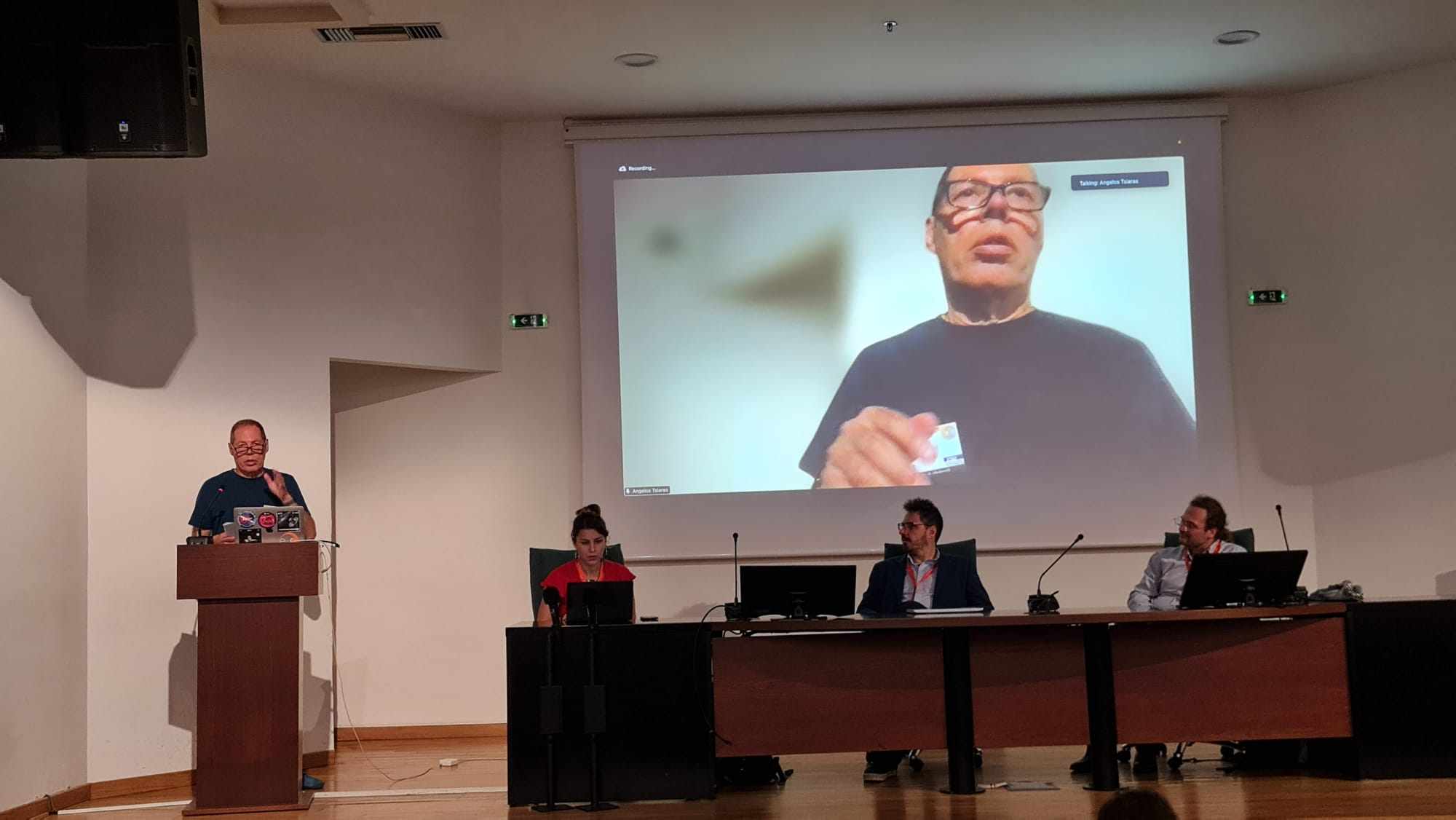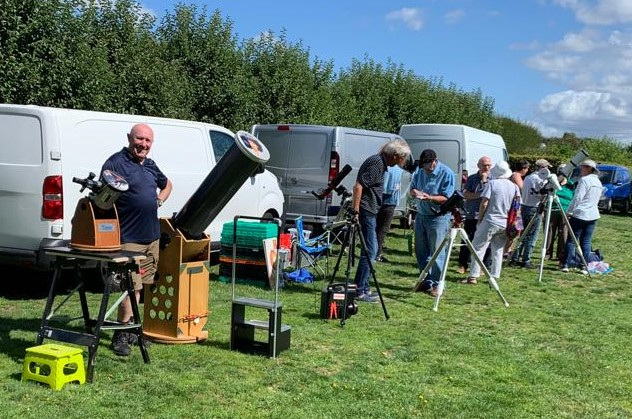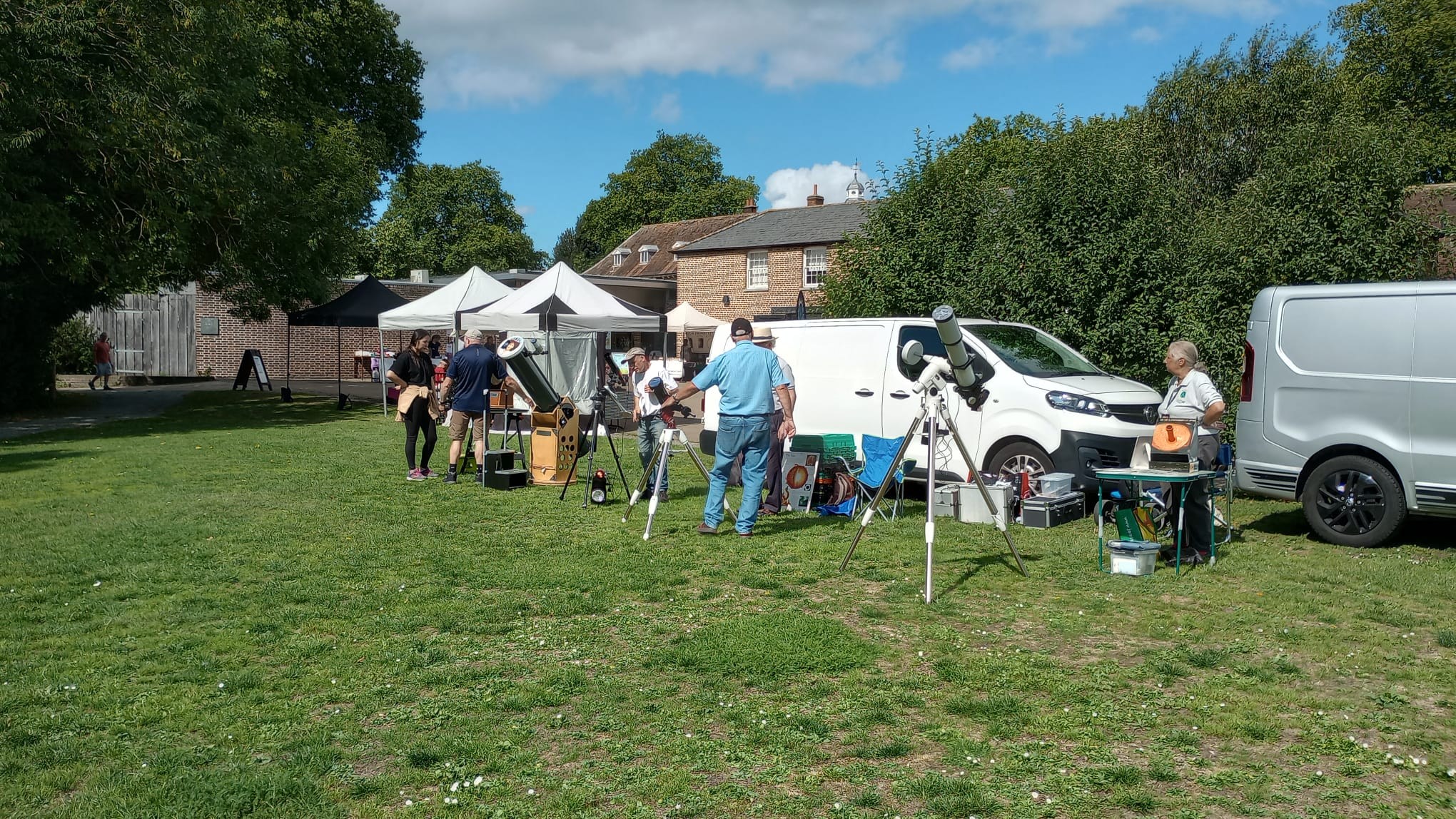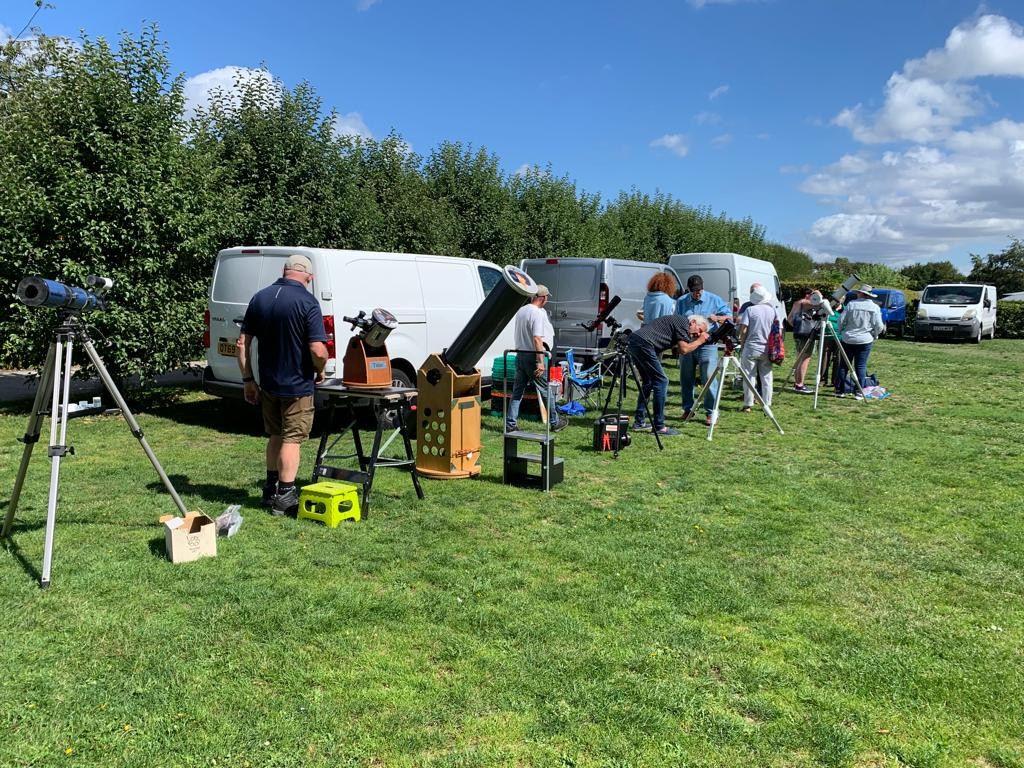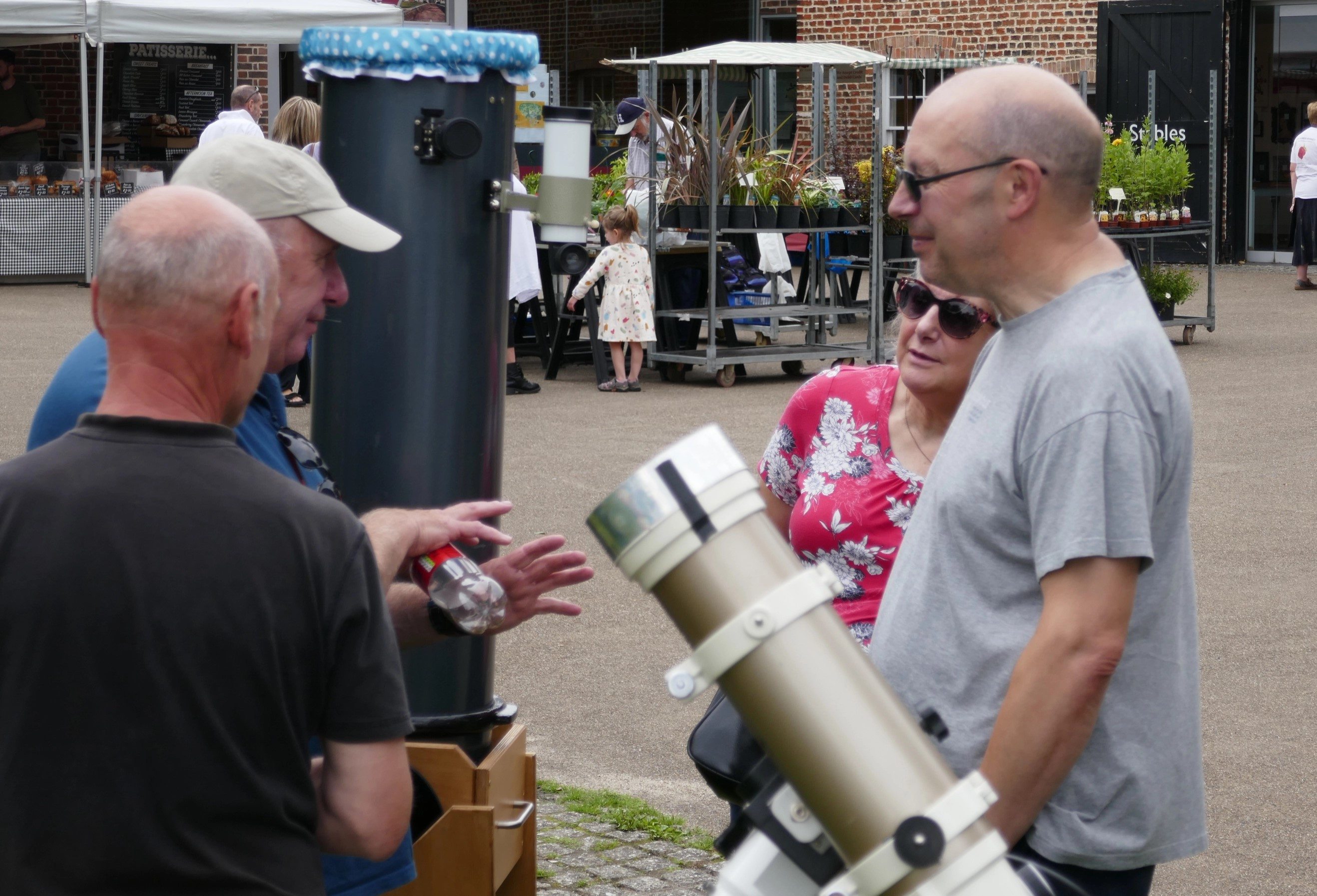Solar Eclipse – 8th April 2024
NEVER LOOK AT THE SUN DIRECTLY. Please click here for solar observing safely.
The solar eclipse of April 8, 2024, also known as the Great North American Eclipse, was a total solar eclipse visible across a band covering parts of North America, from Mexico to Canada and crossing the contiguous United States. A solar eclipse occurs when the Moon passes between Earth and the Sun, thereby obscuring the Sun. A total solar eclipse occurs when the Moon’s apparent diameter is larger than the Sun’s, blocking all direct sunlight. Totality occurs only in a limited path across Earth’s surface, with the partial solar eclipse visible over a larger surrounding region. Ref:https://en.wikipedia.org/wiki/Solar_eclipse_of_April_8,_2024
Member Richard Bohner took these two superb partial solar eclipse photos at approximately 11:20 am from Cottonwood, in Arizona, USA on the 8th April 2024.
Richard captured the images using a Celestron 8” SCT fitted with a solar filter and a Canon 6D set at 1/30 second exposure and ISO 1600.


For more information about the total solar eclipse on the 8th April 2024 check out https://en.wikipedia.org/wiki/Solar_eclipse_of_April_8,_2024.
Stunning Solar Halo by Honor Wheeler
NEVER LOOK AT THE SUN DIRECTLY. Please click here for solar observing safely.
Two stunning Solar Halo images taken by member Honor Wheeler on the 14th April 2024 from Winchester.
Honor captured the Solar Halo’s using a Canon M6II fitted with a Samyang 8mm fisheye lens, ISO100, 1/2500’s & 1/3200’s.
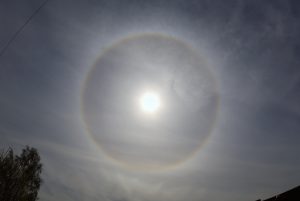
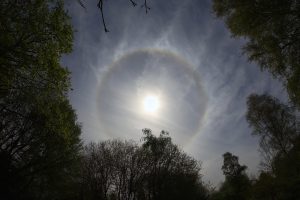
For more information about Solar Halo’s and how they are formed check out https://atoptics.co.uk/blog/atmospheric-halos/.
The Sun – 24th March 2024
NEVER LOOK AT THE SUN DIRECTLY. Please click here for solar observing safely.
A super image of the Sun taken on 24th March 2024 by member Honor Wheeler.
Honor captured the white light image of the Sun using an ED80 Refractor fitted with a solar filter, EQ3-pro Synscan mount, 2x Barlow, Canon M6 II. Exp1/6400s and ISO400.
Below Honor’s image is an image of the Sun on the same day with the sunspots labelled taken from Spaceweather.com.


Photo Ref: https://www.spaceweather.com/archive.php?view=1&day=24&month=03&year=2024
Spaceweather.com reported ”Yesterday, the sun produced a solar flare so strong, it took two sunspots to make it. Sunspots AR3614 and AR3615 exploded in tandem on March 23rd (0130 UT), directing their fire straight at Earth. A National Solar Observatory telescope in Australia recorded the double blast.
The explosion from AR3614 (top) was so violent it seemed to rip the fabric of the sun, while AR3615 (bottom) followed very close behind with a less intense blast of its own.
While this may seem like an incredible coincidence, it probably didn’t happen by chance. Researchers have long known that widely-spaced sunspots can explode in tandem. They’re called “sympathetic solar flares.” Occasionally, magnetic loops in the sun’s corona fasten themselves to distant pairs of sunspots, allowing explosive instabilities to travel from one to the other. This has apparently happened to AR3614 and AR3615.
Some sympathetic flares are so much alike, they are considered to be twins. Yesterday’s double-blast was not a perfect twin, but close enough. It shows that the two sunspots are linked, raising the possibility of more double-flares…”
The NASA Solar Dynamics Observatory captured the sequence and it can be viewed in this movie.
The Worm Moon by Honor Wheeler
Three fantastic Full Moon images taken by CMHASD member Honor Wheeler on the 24th March 2024 from North Kent.
This is the first Full Moon of the spring season and appeared on the night of Sunday 24th March and Monday 25th March reaching its peak illumination in the early hours of Monday 25th March 2024.
In March, the Full Moon is also known as the Worm Moon and if it occurs on or after 21st March it is also known as the Paschal Moon, which is used to determine the date of Easter. In some years the Paschal Moon is the Worm Moon as in this year 2024; in others, it’s the Pink Moon (Full Moon in April). The dates for the Paschal Moon range from the 21st March to the 18th April.
Moonrise half risen
Honor used a Canon M6II, Tamron 18-400mm lens set to 400mm, F8.0, exp1/640s and ISO400.

Full Moonrise
Honor used a Canon M6II, Tamron 18-400mm lens set to 400mm, F8.0, exp1/640s and ISO400.

Full Moon and Blossom
The image below is a composite photo of the moon through an Apricot tree in bloom. The first photo was focused on the moon the second focused on the tree then overlayed using snapseed.
Honor used a Canon M6 II, Tamron 18-400mm lens and Tripod.
For the Moon exposure the settings were; lens set to 400mm, F8.0, exp1/3200s and ISO800.
For the tree exposure the settings were; lens set to 400mm, F8.0, exp1.1/3sec and ISO800.

For more information about the March Full Moon check out https://www.almanac.com/content/full-moon-march and https://www.timeanddate.com/astronomy/moon/worm.html
Comet 12P/Pons-Brooks by Jim Burchell
Another fantastic image of Comet 12P/Pons-Brooks captured on the 27th March 2024 by Jim Burchell using his Seestar S50 smart scope. The image consists of 24 x 10 second images stacked.
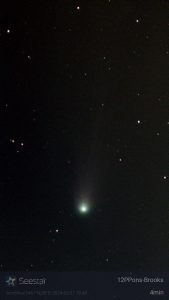
For more information about the comet 12P Pons-Brooks check out https://ras.ac.uk/news-and-press/news/12ppons-brooks-how-and-when-see-devil-comet
Bode’s Galaxy (M81) & the Cigar Galaxy (M82) by Jim Burchell
Bode’s Galaxy also known as Messier 81 (M81) is a grand design spiral galaxy which lies approximately 11.8 million light-years from Earth, with an apparent magnitude of 6.9.

Exoplanet transit of Qatar-9b
One more for the Exoclock project. This time the transit of exoplanet Qatar-9b measured by Simon Dawes and Martin Crow on the same night. Qatar-9 b is a hot Jupiter exoplanet in Ursa Major that orbits a K-type star. Its mass is 1.19 Jupiters, it takes 1.5 days to complete one orbit of its star and is 0.0234 AU from its star. Its discovery was announced in 2019.


The Sun by Jim Burchell – 24th March 2024
NEVER LOOK AT THE SUN DIRECTLY. Please click here for solar observing safely.
A super image of the Sun taken by member Jim Burchell. The image is showing an extremely large Sunspot group AR3615 in the middle of the Sun.
Jim took the single image using a Pentax KP camera attached to a 102 mm Altair refactor fitted with a solar filter and then processed in Snapseed.
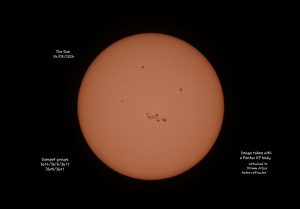
The Moon by Neil Webster
A super selection of Moon images taken by member Neil Webster in March 2024.
22nd March 2024
A Waxing Gibbous Moon, 94.7% illuminated and 12.47days old.
7 frames each 90s x 32fps. Best 20% aligned and stacked in Autostakkert. Processed in PhotoShop.
Neil captured the Moon using an AA115 triplet APO, EQ6 R, ZWO 290MM and Astronomik R/IR filter (642-840nm).



24th March 2024
A Waxing Gibbous Moon, 99.9% illuminated and 14.53 days old.


Check out Neil’s flickr page for higher resolution images at https://www.flickr.com/photos/137388222@N05/
Comet 12P/Pons-Brooks by Jim Burchell
Two fantastic images of Comet 12P/Pons-Brooks taken on the 15th & 18th March 2024 by member Jim Burchell. The images were taken using a Seestar S50 smartscope. On both nights Jim had a very small amount of time to capture the comet due to clouds rolling in. The image taken on the 15th is a stack of 6×10 second images and the image on the 18th is a stack of 18×10 second images.
Comet 12P/Pons Brooks on 15th March 2024

Comet P12/Pons Brooks on 18th March 2024

For more information about the comet and how to locate it check out https://www.skyatnightmagazine.com/advice/comet-12p-pons-brooks
The Sun – 25th Feb 2024 by Jim Burchell
NEVER LOOK AT THE SUN DIRECTLY. Please click here for solar observing safely.
A splendid image of the Sun taken on the 25th February 2024 by member Jim Burchell. Jim captured the image using a Seestar S50 smart scope fitted with a solar filter and processed in Snapseed. The giant sunspot AR3590 that can be seen on the Sun in Jim’s image was more than ten times wider than Earth when the image was taken.

Messier 52 by Diane Clarke
A super image of Messier 52 or M52, also known as NGC 7654 taken by member Diane Clarke on the 6th March 2024 during a brief clear spell in the weather.
Messier 52 is also known as the Scorpion Cluster or the Salt & Pepper Cluster and it is an open cluster of stars in the constellation of Cassiopeia. The cluster has an apparent magnitude of 6.9 and lies at an approximate distance of 4,600 light years from Earth.
Diane acquired the image using a Seestar S50 smart scope, 270 x 10s subs, stacked & processed using Affinity Photo.

ExoPlanet transists 2023 by Simon Dawes
A nice montage of the ExoPlanet transists Simon did in 2023 for the ExoClock project.

The Whirlpool Galaxy (M51a) by Diane Clarke

Lunar Clair-obscur Effects – French for “light” (clair) and “shadow” (obscur)




The Orion Nebula by Jim Burchell
A lovely image of the Orion Nebula (Messier 42/M42) taken by Jim Burchell on the 23rd February 2024 using a ZWO SeeStar S50 smart scope. The image is a stacked image containing 12 minutes of 10 second images. Jim said ”Considering the Moon phase was 97% illuminated I was quite impressed with the image.”

The Orion Nebula (M42) by Dr Mike Rushton
A superb image of the Orion Nebula (Messier 42/M42) taken by Dr Mike Rushton on the 3rd March 2024.
Mike acquired the image using a Dwarf2 telescope from DWARFLAB and took 400 subframes of 10 secs which was then processed in SIRIL.

The Sun by Jim Burchell – 1st March 2024

IC434, Horsehead Nebula and NGC2024 Flame Nebula by Kevin Langford
A fantastic image of IC434, the Horsehead Nebula & Flame Nebula (NGC2024) in the constellation Orion by member Kevin Langford. The image was taken on the 19th January 2024 from Bexley, Kent.
Kevin acquired his image using a ES 102ED APO, 0.7x focal reducer corrector, EQ5 Pro, ZWO ASI071, Orion MMAG and a L-enhance filter. A total of 2.45 hours of exposures.
IC434 is a bright emission nebula in Orion. It was discovered on February 1, 1786 by William Herschel.
The Horsehead Nebula is a small dark nebula silhouetted against IC 434 and is located near to the star Alnitak (ζ Orionis) which is a triple star system at the eastern end of Orion’s belt. The Horsehead Nebula is approximately 1,375 light-years from Earth. It is one of the most identifiable nebulae because of its resemblance to a horse’s head.
The Flame Nebula (NGC2024) is also an emission nebula, it has a radius of 6 light-years and located about 1350 light-years away from Earth.

AstroFest 2024
Many members have been at AstroFest this weekend, but it looks like the cost of living crisis and high prices seem to be having an impact, with many retailers and manufacturers not exhibiting at AstroFest this year. At least there isn’t the crush of people from past years and a bit more space to have a coffee and cake or get get some practice in docking to the ISS.
Janice Receives the Lydia Brown Medal from the BAA
Janice received the Lydia Brown medal from the BAA in recognition of meritorious service to the Association in an honorary capacity over many years.



Occultation of Asteroid 2000 SZ278

Occultation by Asteroid 2000 SZ278 on 2024-01-26
The Moon – 17th Dec 2023
A lovely image of a Waxing Crescent Moon taken on the 17th Dec 2023 by member Honor Wheeler. On this day the Moon was 4.72 days old, 27.01% illuminated and in the constellation Aquarius.

The image was taken using a Skywatcher ED80 Refractor, Skywatcher EQ3 Synscan mount, x2 Barlow, Canon M6 MRKII Camera set at ISO100 and exp. 1/20s.
CMHASD Christmas Quiz – 2023
Congratulations to team Dalek for winning this years CMHASD Christmas Quiz.

Team Dalek
Member’s Rita Whiting and Debra Holton pulled out all the stops to provide a night of head scratching, puzzlement and fun. Thank you Rita & Debra for all your hard work & effort creating the quiz. It was a great night and we are all looking forward to the next one!
The Moon – 19th Dec 2023
A stunning 10 frame image of the Moon taken by member Neil Webster on the 19th Dec 2023. The Moon was in the First Quarter phase, 47% illuminated, 7.07 days old and in the constellation Pisces.
The First Quarter phase comes roughly 7 days after the New Moon and is when the moon has completed one quarter of its orbit around the Earth hence the name First Quarter. The Moon in this phase is also referred to as a Half Moon too.
Neil acquired is image using a R/IR filter, ZWO ASI 290MM, EQ6 R, AA 115 triplet APO, and Firecapture. 10 frames stitched in Microsoft ICE. Each 90s x 33fps. 20% stacked in AutoStakkert. Post processed in Photoshop.
Below are a couple of individual frames from the above image.


To see more of Neil’s brilliant images check out his flickr page at https://www.flickr.com/photos/137388222@N05/with/53409456667/
Venus, Spica & Moon – 8th Dec 2023
Two super images by member Jim Burchell taken on the 8th Dec 2023. The 1st image shows Venus, the star Spica and the Moon going lower left to top right. Spica is the brightest star in the constellation of Virgo and one of the 20 brightest stars in the night sky. The 2nd image is of the Moon with Earthshine.

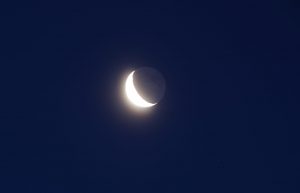
The Moon on the 8th December 2023 was 24.88 days old, 22.05% illuminated and in the Waning Crescent phase. This is the phase where the moon is less than 50% illuminated but has not yet reached 0% illumination which would be a New Moon.
Jupiter using a red filter – 5th Dec 2023
A great image of Jupiter taken by member and trustee Simon Dawes.
The image was taken on the 5th Dec 2023 using a Celestron EDGE11HD, with a red filter, f2800mm (f10), Rising Cam CMOS sensor and Mesu e200 mount. Sharpcap Pro, 2 min of video, stacked in AutoStakkert, processed in Registax 6 and Photoshop.
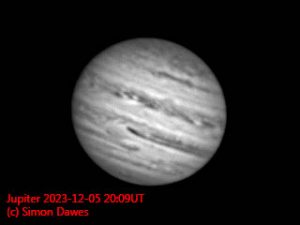
For more member images of Jupiter check out the Jupiter section on our website.
For more information about using filters for visual observing of the Moon and planets https://britastro.org/2018/filters-for-visual-observing-of-the-moon-and-planets
Moon – 28th Nov 2023
Two lovely images of the Moon taken by members Jim Burchell & Kevin Langford on the 28th Nov 2023.
On this day, the moon was 14.57 days old, 99.58% illuminated and so in the Waning Gibbous phase and found in the constellation Gemini. The Waning Gibbous phase is the first phase after the Full Moon. It lasts roughly 7 days with the Moon’s illumination growing smaller each day until the Moon becomes a Last Quarter Moon with an illumination of 50%, sometimes referred to has a half moon.
Gibbous has its origins in the Late Latin word gibbosus, meaning ‘humpbacked’ and the Latin word gibbus, meaning “hump.” It was adopted into Middle English to describe rounded, convex things.
Kevin Langford’s image taken using a Cannon 750D and a 150 to 600 mm Sigma lens.
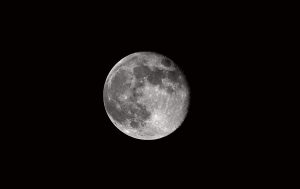
Jim Burchell’s image taken using a Pentax KP, F8.0, 1/400 sec, 300mm, iso 800 and cropped in Snapseed.

Aurora – Norway – November 2023
Member George Buckberry’s sister Val Hicks went on a cruise up to the North of Norway in November this year and has kindly shared her photos with us of the stunning Aurora display that she saw. Some truly beautiful images 🙂
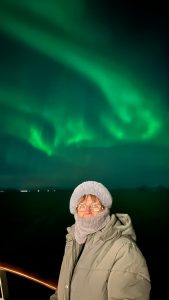

Lunar Halo – 25th Nov 2023
A stunning example of a Lunar Halo captured by 3 members of the society – Leigh Slomer, Honor Wheeler and Simon Dawes on the evening of the 25th Nov 2023. The white dot at the 4 o’clock position from the Moon is the planet Jupiter.
The ring around the Moon – or ‘lunar halo’ is caused by the refraction of moonlight from ice crystals in the upper atmosphere. For more information check out https://atoptics.co.uk/blog/moon-halo/
Leigh Slomer

Honor Wheeler

Simon Dawes

The Sun by Jim Burchell – 23rd Nov 2023

Shears Green Junior School – Cosmic Camp 2023
Several society members attended Shears Green Junior School on Friday 15th September 2023 with their own or a society telescope to take part in the school’s ‘Cosmic Camp’. The Society would like to say a big thank you to all the members who helped make this event a success.
Member Diane Clarke who attended the event wrote ”Earlier in the year the CMHASD was again invited to the Shears Green Junior School Cosmic Camp. So we took our telescopes along to offer views of various stella sights.
In the evening Jupiter & 3 of its Galilean moons appeared above the horizon and was again greeted with awe & wonder by all who viewed them. There was also views of Cygnus & the planet Saturn with its largest moon Triton.
The double star Mizar (Alcor) in Ursa Major also proved a great hit when the children discovered that 1 star was actually 2 stars.
As well as showing the children the night sky we also had some classroom presentations and a display of members images along with an image from the JWST on show.
The members who went along had an extremely enjoyable and rewarding time due to the enthusiasm of all the children & teachers at the camp. Lots of questions were asked by a very inquisitive & enthusiastic young audience and as they looked through the telescopes we heard were phrases such as “wow”, “is that real?” & “is it a hologram?”
One of the teachers from the school wrote in a thank you email to us “We all had such a fantastic time last Friday and the children didn’t stop talking about it for days.”
We look forward to next year 🙂”
The Society did not take any photos of the event as there were too many safeguarding issues.
Comet Lemmon C/2023 H2 – Nov 2023
Superb image of Comet Lemmon C/2023 H2 taken by member Richard Bohner on the 11th Nov 2023 from Arizona, USA. Richard used the following to acquire his image – Canon 5D Mk IV on a Celestron 8” SCT. Magnification about 100X. 60 seconds exp. At ISO 10K.

The comet was discovered on April 23, 2023 with a robotic 1.5m reflector telescope of the Mount Lemmon Survey, hence the name Comet Lemmon (C/2023 H2). That program is part of the Catalina Sky Survey based at Stewart Observatory’s Catalina Station near Tucson, Arizona, which combs the sky each night in search of new comets and asteroids. The comet is just one of an incredible 50,000 asteroids and comets discovered by the Mount Lemmon Survey, making it one of the most prolific minor planet-discovering surveys currently operating.
During mid-November the comet was moving across the western sky from the constellation Hercules through Aquila just below the Summer Triangle asterism.
More ExoPlanet transits for the ExoClock Project – Nov 2023
Five more transits done!
TOI-3688 A b is a gas giant exoplanet that orbits a G-type star. Its mass is 0.98 Jupiters, it takes 3.2 days to complete one orbit of its star and is 0.0456 AU from its star. Its discovery was announced in 2023.
https://exoplanets.nasa.gov/exoplanet-catalog/8781/toi-3688-a-b/



Exoplanet GPX-1 b is in the constellation of Perseus. GPX-1 b is a gas giant exoplanet that orbits an F-type star. Its mass is 19.7 Jupiters, it takes 1.7 days to complete one orbit of its star and is 0.0338 AU from its star. Its discovery was announced in 2021.

Exoplanet Qatar-5b is located in the Andromeda constellation. Qatar-5 b is a gas giant exoplanet that orbits a G-type star. Its mass is 4.32 Jupiters, it takes 2.9 days to complete one orbit of its star and is 0.04127 AU from its star. Its discovery was announced in 2017.
https://exoplanets.nasa.gov/exoplanet-catalog/3488/qatar-5-b/
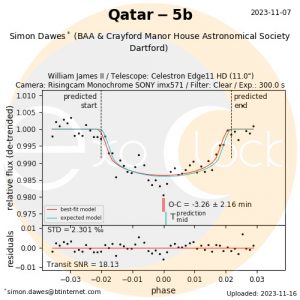
CMHASD Stargazing at Hall Place, Bexley – Wed 22nd Nov 2023
On Wednesday 22nd November 2023, CMHASD were back at Hall Place & Gardens to hold a star gazing event from 7pm to 9pm. We had brilliant support from our members who bought along a variety of telescopes, cameras, meteorites and other displays for our guests.
CMHASD Chairman John Archer wrote ”Last week at Hall Place we had one of our best ever for observing and public enjoyment. Although these events take quite a bit of setting up, and time out of the diary, they are extremely rewarding. We managed a couple of talks – “choosing a telescope (or not)” from Mike being the customary first talk. Initially we were clouded out, however it became apparent that during the first talk, some gaps were appearing, so we invited the public outside. They were treated not just to a brilliantly positioned Jupiter, but also a prominent Moon, and far off Saturn even got in on the act. Finally, we managed to coax the visitors back in for tea, a comet talk and demo for which I’m grateful to Debra for the ingredients list and instructions – it wasn’t quite Bake-off but the resulting comet at least didn’t have a “soggy bottom” thanks partly to sublimation!
A big thank you to the whole team for once again supporting the event.”
Below are a few photos showing some of the celestial delights our guests got to view/image and one of the comet Debra made too 🙂





Congratulations to Dave Grist & Steve Floodgate
A huge congratulations to CMHASD members Dave Grist and Steve Floodgate for receiving the BAA Horace Dall medal & gift this year.

Chairman John Archer wrote ”For anyone who travelled up to the Institute of Physics last Saturday or tuned in via Zoom for the BAA meeting would have seen this year’s recipients of the Horace Dall medal & gift – “The award shall be made to a person, whether or not a member of the Association, who has shown marked ability in the making of Astronomical Instruments. If two or more people have been jointly concerned in a particular work then each person may receive a medal and gift.” This year the worthy recipients were our very own Dave Grist and Steve Floodgate, expert converters of spare and unloved telescopes into fantastically popular and fun to use Dobsonians. Well done both of you – we’re proud of your achievements and grateful for your continued efforts contributing to the Society practical observing and outreach.”
Below is a selection of photos showing Dave & Steve being presented with their medals by the President of the BAA David Arditti on Saturday 9th December 2023 at the BAA Christmas Meeting. Well done guys 🙂



Autumn Equinox Star Party – Kelling Heath, Norfolk – Oct 2023
Below is a brief summary of the latest trip by CMHASD members to Kelling Heath for the Autumn Equinox Star Party written by Simon Dawes.
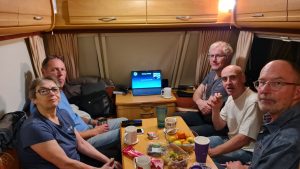
”10 Members, 5 pitches, 2 tents, 2 caravans, 1 camper van and a lodge set the scene for a damp and windy long weekend.
If you decided to go to the Autumn Kelling Heath star camp based on the weather forecast, you would never leave Crayford; fortunately us seasoned star campers know better than to believe the forecast.
Wednesday: Cloud, Wind and Rain.
Four of us arrived in the rain, setting-up camp in a brief gap in the weather and headed to Honor’s lodge for a very welcome evening meal.

Thursday: Cloud, Wind and Rain.
Some of us headed out for a walk to the beach stopping for tea and cakes at the village cafe, a cloudy night saved by us zooming into the Barry Kellet lecture.


Friday: Cloudy, Windy, and a clear night.
The short term forecast suggested a clear night, the clouds parted early and we weren’t disappointed, we had views through Dominique’s a very nicely set-up 3” Refactor, Keith’s 10” Dobsonian, Simon’s 12” Dobsonian, Julian’s 20” Dobsonian, and some very nice 4” Binoculars from a nearby pitch.

It was too windy for imaging early on but the wind died down and David did a good job imaging using a Samyang 130mm Lens on an HEQ5 mount – possibly overkill – but the results spoke for themselves.
We packed up at about 3:30 am.
The sky at Kelling by Kevin Smith

The Milky Way by Simon Dawes
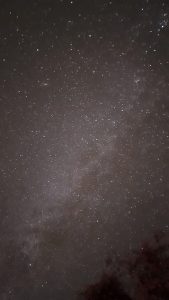
Images below are by Martin Crow
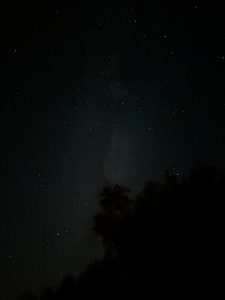
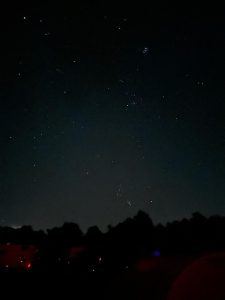


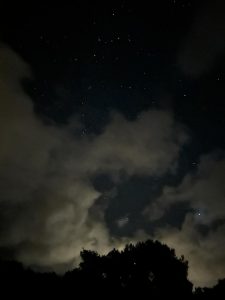
Below are images by Jim Burchell. All images where taken with a Pentax KP attached to a Skywacher star adventurer. All the images are single frame images.


Saturday: Dry, partial cloud during the day, mostly cloudy at night
We visited the trade stands, being careful to leave our wallets behind. Julian had some wonderful views of the Sun in his Ha telescope a modified PST.
Sunday: Dry
We packed up and headed home.”
Plus Kevin had a cute little visitor one night to his tent 🙂
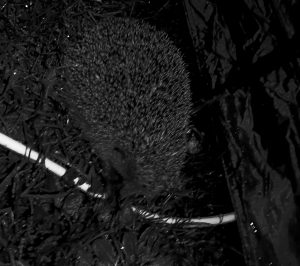
Sundogs & 22-degree Halo by Jim Burchell
Fine examples of sundogs and part of a 22-degree halo captured by member Jim Buchell on the 25th September 2023 from Dartford.
”A sundog, also known as sun dog, mock sun or parhelion, consists of glowing spots around the sun. They are created by sunlight refracting off plate-shaped ice crystals in the cirrus clouds. Sundogs are some of the most frequently observed atmospheric optical phenomena and can be observed throughout the year and anywhere in the world. They are also associated with 22-degree halos.
Sundogs tend to be most visible when the Sun is close to the horizon. The part of a sundog closest to the Sun tends to be red in colour, while the areas further away from the Sun generally appear blue or green.” Ref:https://www.timeanddate.com/astronomy/optical-phenomenon.html

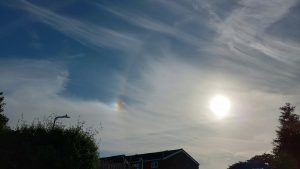
For more information about sundogs and 22-degree halo’s check out https://atoptics.co.uk/blog/sundogs-sun-dogs-parhelia-mock-suns/ and https://atoptics.co.uk/blog/22-halo-formation/
Development of Sunspot AR3395 by Simon Dawes
A nice set of images showing how the Sunspot AR3395 developed over 5 days as it moved across the Sun in August by member Simon Dawes.

ExoClock Conference, Thessaloniki, Greece 2023
2023 October 21/22
Aristotle University of Thessaloniki, Greece
3rd ExoClock Annual Meeting
CMHASD trustees Martin Crow, Simon Dawes and Dr Mike Rushton attended the 3rd Annual Conference of ExoClock in Greece, a project to improve the ephemeris of exo-planet transits for the European Space Agencies, Aerial Mission, due to launch in 2029.

During the conference Martin and Simon were awarded ‘Silver Awards’ for reaching over 100 successful ExoClock observations. Congratulations Martin & Simon!


Below are 2 accounts of the trip written by Martin and Simon.
Martin wrote ”When this year’s annual meeting was announced and that it was going to be in Greece, it felt that it was important to attend in person. The previous in person meeting, the first one since lock down, had been held at UCL in London. Because the project is international the annual meetings are a rare opportunity to meet other like-minded observers who we only normally see over Zoom.
Simon (who is also a regular contributor to ExoClock) and Mike (who is interested in the project and has done some transits with his EvScope) also come along.
We flew out on the Thursday which give us a free day to explore Thessaloniki before the weekend meeting. Our hotel was well placed in the middle of Thessaloniki although it was on a busy road junction.

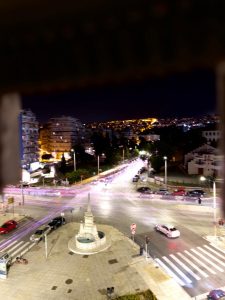
I knew nothing of the place before we went. It is steeped in history and in cats. Yes cats. They were everywhere.
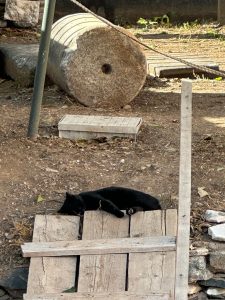

The Museum of Archaeology showed off the amazing finds of stuff made in and around Thessaloniki generally between 2000 and 2400 years ago. Delicate pottery and intricate gold jewellery, which had only survived because they were grave goods, were on display. The workmanship was incredible.

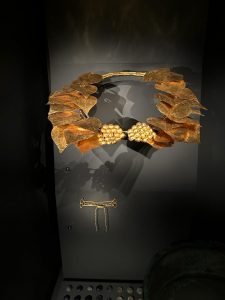

We also visited the White Tower (Middle Ages), the Rotunda (Roman) still with its domed roof and some of the massive city walls.

The weather was warm and there were plenty of restaurants to choose from. We took advice from the locals and kept away from the main tourist drags. The food was good, not expensive, and the portions were large. What not to like – providing you are not a vegan or veggie – there was a lot of meat.

The location of the meeting was just a 15-minute walk from the hotel.
The Saturday meeting kicked off with an Introduction given by Anastasia Kokori from UCL and various talks followed about the science surrounding the Ariel space telescope, the evolution of hot Jupiter’s and the possible use of machine learning with charting exoplanets.
After lunch there were more talks about Ariel and ExoClock. Following on from afternoon tea were more talks relating to the ExoClock project. Some were better than others.
On Sunday the day started off with talks from students taking part in ExoClock and using its data.
There were then two short talks given by amateur astronomers. One of them was me. The brief was to talk about our experience of being involved with the ExoClock project. I described when I had first got started and the positive and supportive aspects of the software and project in general. I finished by putting it all into context, that is to say, how it allows me as an amateur astronomer to contribute to an area that is a frontier of astronomical research. Awesome.

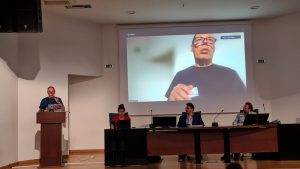
After the coffee break there were some very interesting talks/discussions about the focus groups and, also, education outreach in schools.
Finally, after lunch, there was more on the working groups some of which, I have to say, that I struggled to follow. Plus, it had been a long day!!
What I liked about the talks was that they were not too long, mostly 20-minutes. This is a good length and kept my attention, any longer and I would be drifting off. I found most of the topics interesting with fresh information on top of what I already knew.
All in all, a very worthwhile trip.”

Simon wrote ”We arrived on Thursday evening, and after dinner at a traditional Greek Taverna (ταβέρνα in Greek) we headed back to the hotel for Tea, in time to ‘zoom in’ to the societies lecture by Paul Money on the Vikings on Mars.
The following day was dedicated to sightseeing, Thessaloniki Archaeological Museum, The Arch of Galerius, The Rotunda (also commissioned by Galerius in the 4th Century AD), The Water Front and the White Tower and finally the Roman wall. One day really wasn’t enough for the sights and sites and we only scratched the surface of what Thessaloniki has to offer.


The conference was over 2 days, most lectures being 30 minute in length and ranging from the easy to follow to the latest mathematical, statistical and AI techniques associated with the Aerial and related Space Missions. Including, in one of the talks, a description of 24hrs of wasted Hubble time due to inaccurate exo-planet transit timings, really bringing home the impact amateur astronomers can have in this field by improving these ephemeris. There were also many talks on how MSc students were using exoclock data (hopefully crediting the observers) to understand better the characteristics of these planetary systems.


Martin and I were both awarded ‘Silver Awards’ for reaching over 100 successful observations (which is approximately 1000 hours of observing and maybe 300 hours in processing when you also take into account the failures due to weather or equipment issues) by the Principle Investigator (Giovanna Tinetti) and the leader of the Exo-Clock programme (Anastasia Kokori).
We headed home on Monday morning.”
For more information about the conference click here https://www.exoclock.space/annual_meetings
ExoPlanet transit of HAT-P-23b by Keith Rickard
One more for the ExoClock project – this one being the first for CMHASD trustee and treasurer Keith Rickard. It is of Exoplanet HAT-P-23b in the constellation Delphinus.
”HAT-P-23 b is a gas giant exoplanet that orbits a G-type star. Its mass is 2.09 Jupiters, it takes 1.2 days to complete one orbit of its star, and is 0.0232 AU from its star. Its discovery was announced in 2010.” Ref:https://exoplanets.nasa.gov/exoplanet-catalog/1345/hat-p-23-b/
For more information about HAT-P-23b click here https://exoplanet.eu/catalog/hat_p_23_b–737/

Superb Sun Pillar imaged by John Archer
Whilst travelling early morning on a train to London, CMHASD Chairman John Archer saw this fine example of a sun pillar on the 23rd October 2023.
”Sun pillars and light pillars are beams of light that extend vertically upward (or downward) from a bright light source, such as the sun or another bright light low on the horizon. They can be 5 to 10 degrees high and sometimes even higher. In fact, they might lengthen or brighten as you gaze at them. They’re beautiful and wondrous. And they’re also the source of some UFO reports!
When is the best time to see them?
You’ll most often see sun pillars when the sun is low in the western sky before sunset, or low in the east just after the breaking of dawn. However, you might even see a sun pillar when the sun is below the horizon. On the other hand, you can see light pillars at any time of night. They’re called sun pillars when the sun helps make them. But the moon or even streetlights can create this light phenomenon, too, in which case the name light pillar is more appropriate.” Ref:https://earthsky.org/earth/what-is-a-sun-pillar/
For more information about sun pillars see Les Cowley’s brilliant website Atmospheric Optics .


Comet C/2023 P1 (Nishimura) imaged by Martin Crow
C/2023 P1 (Nishimura) is a long-period comet discovered by Hideo Nishimura on 12 August 2023 and member Martin Crow imaged it on the 20th August 2023. At the time of its discovery, the comet was in the constellation of Gemini and shining at magnitude +10.4.

Image details: 5x60sec exposures. 235mm diameter SCT @ f5.4, SX694 mono CCD.
ExoPlanet TrES-3b transit – observed by Simon Dawes
Another for the ExoClock project by Simon Dawes of the transit of exoplanet TrES-3b.
TrES-3b is in a very tight orbit around its host star, TrES-3, transiting the stellar disk once per 31 hours. For comparison, Mercury orbits the sun once every 88 days. TrES-3b is just a little larger than Jupiter, yet orbits around its parent star much closer than Mercury does, making it a “hot jupiter.”

The Milky Way by Honor Wheeler – Oct 2023
Four superb single shot images of the Milky Way captured by member Honor Wheeler whilst on holiday in Kelling Heath, Norfolk. In one of the photo’s there is a meteor!




CMHASD supporting the BAA at New Scientist Live – ExCel London 2023
Crayford Manor House Astronomical Society Dartford (CMHASD) were out in force at the recent New Scientist Live event at ExCel Centre, London Docklands on the 7th to 9th October 2023. We were there to help the British Astronomical Association (BAA) on their stand over the 3 days to promote the BAA and answer questions from members of the public, school children and teachers on all things astronomical.
CMHASD member Diane Clarke wrote ”As part of our display we had several 3D printed items which included: M51, painted scale models of the planets Mars & Jupiter and a section of the largest canyon in the Solar System the Valles Marineris.
All of these proved great talking points enabling us to make several sales as well as promoting membership of the BAA.
Among the visitors to the BAA’s stand was Professor Richard S. Ellis with his family; who had earlier in the day given a talk titled When galaxies were born: First results from the James Webb Space Telescope to a packed audience.
All in all, everybody who staffed the stand enjoyed the experience. Over the 3 days their enthusiasm & knowledge radiated to everybody that visited the stand, hopefully resulting in future new members of the BAA.”

CMHASD would like to thank all their members who helped over the 3 days and to Diane Clarke for sharing her photos of the event.
CMHASD Solar Observing at Hall Place – 19th August 2023
NEVER LOOK AT THE SUN DIRECTLY. Please click here for solar observing safely.

On Saturday the 19th of August several members of the Society were present for the second of our 2 solar observing sessions at Hall Place & Gardens. Below are some photos of the day. Thank you to Dr Mike Rushton, Honor Wheeler, Jim Burchell, Omila and Diane Clarke for sharing your photos.
The Sun in Hydrogen Alpha taken by Honor Wheeler using a Personal Solar Telescope (PST).


The Sun in white light taken by Omila using an iPhone with an adapter and telescope fitted with a Solar filter.


Full Moon & the final Supermoon of 2023 – 29th Sept 2023
Several CMHASD members were out on the 29th September 2023 to image the final Supermoon of 2023 and below are their images. This full Moon is also known as the Harvest Moon as it is the closest Full Moon to the September equinox this year.
Most years, the Harvest Moon is in September but around every three years it’s in October. When the Harvest Moon occurs in September it replaces the Corn Moon. When it happens in October it takes the place of the Hunters Moon.
Kevin Smith’s image taken from Deal, Kent.

Honor Wheeler’s images taken from Dartford, Kent.
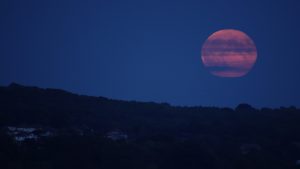


Dominique Ferrand’s image taken from Cordoba, Spain. Dominique’s image is of the full Moon and Jupiter.

For more information: https://www.timeanddate.com/astronomy/moon/harvest.html
Annular Solar Eclipse 2023 – Richard Bohner
NEVER LOOK AT THE SUN DIRECTLY. Please click here for solar observing safely.
On Saturday 14th October 2023 an annular solar eclipse crossed North, Central and South America.

Member Richard Bohner; who lives in the USA wrote ”Hello all. There will be an annular solar eclipse here in Arizona on 14 October at 9:30 AM. The path is crossing the “Four Corners” area (where Utah, Colorado, Arizona, New Mexico come together). I am coming back from a week holiday in Colorado, but leaving early in morning (6 AM) to get to my spot to observe the eclipse at 8:30 AM. I will have photos to post.” and here they are…







Some info on eclipse – Moon distance 246,504 miles and Moon coverage of sun 95.2%
Richard used his old Meade ETX 70 to acquire the photos.
The Sun and the Wilson Effect – Simon Dawes
NEVER LOOK AT THE SUN DIRECTLY. Please click here for solar observing safely.
On the 26th September 2023 member Simon Dawes imaged the Sun. One of his images of the sunspots on the Sun that day showed an interesting effect called the ‘Wilson Effect’. The Wilson effect is the perceived depression of a sunspot’s umbra or centre in the Sun’s photosphere.

Sunspot AR3443 showing the ‘Wilson Effect’

https://britastro.org/section_information_/solar-section-overview/wilson-effect-observers-challenge
WOW – Rare Super Blue Moon captured by Jim Burchell
A fantastic image of a Full Moon, a Supermoon and finally a Blue Moon all captured by member Jim Burchell on the 30th August 2023 from Dartford top road in Kent. WOW!!!!
The combination of a Blue Moon and Super Moon is very rare, so this was a very rare chance to see what is known as a Super Blue Moon. The last one was back in 2009 and we will have to wait until 2037 to see it again.

A blue Moon happens when the pattern of days in a year means there are 13 full Moons instead of the usual 12 and so one month has 2 full moons. This year the month of August had 2 full Moons.
Anyone hoping to seen the Moon tinged the colour blue would have been disappointed. The name of the Moon has nothing to do with colour but instead is so called because it does not fall in the usual scheme of named Moons. It is thought that the rarity is where the phrase “once in a blue Moon” may come from. The last blue Moon was in August 2021 and the next one will be in 2026.
This blue Moon is also known as a supermoon too and so appeared larger and brighter than usual in the sky. This was due to the fact that the Moon was near it’s closest point in its orbit around the Earth.
Finally, the 30th Aug 2023 full moon was the biggest and brightest Super Moon of the year as this year there are 4 Supermoons!
For more information click on this link https://moon.nasa.gov/news/197/super-blue-moons-your-questions-answered/
ExoPlanet transit of TrES-3b by Dr Mike Rushton
The transit of Exoplanet TrES-3b by CMHASD member & trustee Dr. Mike Rushton using an eVscope for the ExoClock project.

TrES-3b is a gas giant exoplanet orbiting the star GSC 03089-00929 a G-type star and is 0.02282 AU from its star. It has an orbital period of just 31 hours and nearly twice the mass of Jupiter. It was found by the Trans-Atlantic Exoplanet Survey in 2007. It was discovered in the constellation Hercules about 10 degrees west of the star Vega.
The planet TrES-3b is named Umbäässa. The name was selected in the NameExoWorlds campaign by Liechtenstein, during the 100th anniversary of the IAU. In the local dialect of southern Liechtenstein, Umbäässa is a small and barely visible ant.
Crepuscular rays at the pavilion by Honor Wheeler
A lovely image taken by member Honor Wheeler on the 10th August 2023 whilst at the pavilion on an informal night of some crepuscular rays.
”Crepuscular rays are sunbeams that originate when the Sun is just above or below a layer of clouds, during the twilight period; which extend over the western sky radiating from the position of the Sun. Crepuscular comes from the Latin word crepusculum meaning “twilight”. Loosely, the term crepuscular rays is sometimes extended to the general phenomenon of rays of sunlight that appear to converge at a point in the sky, irrespective of time of day.” Ref: https://en.wikipedia.org/wiki/Crepuscular_rays
”The radiating appearance of the bands is caused by perspective, as demonstrated by the fact that when on rare occasions the rays extend across the entire sky, they appear to converge again on the eastern horizon. This rare related phenomena are called anticrepuscular rays and so appear at the same time (and coloration) as crepuscular rays but in the opposite direction of the setting sun (east rather than west).” Ref: https://www.britannica.com/science/crepuscular-ray

ExoPlanet TOI-1728b transit by Martin Crow
Another for the ExoClock project by CMHASD member & trustee Martin Crow of ExoPlanet TOI-1728b; a warm Super-Neptune orbiting an M-dwarf host.

Daytime Moon by Simon Dawes
Superb image of a daytime Waning Gibbous Moon (60% illumination) taken on the 7th Aug 2023 by CMHASD trustee & member Simon Dawes.

Moon & Jupiter by Diane Clarke
A lovely image of the Moon and Jupiter taken by member Diane Clarke.
Diane wrote ” Jupiter & the Moon 4° apart. I went to image this event as it rose above my local horizon, but the sky was cloudy so I decided to wait as both Jupiter & the Moon would need to clear a local stand of trees. Fortunately, after they cleared the trees the sky broke giving me the opportunity to take an image of the event.
Image taken: 01.10.23 @22.33 hrs BST. Camera: Canon EOS M50m2. Lens: Canon EF L 100 – 400mm @ 160mm, F-stop f/5.6 @ 1/320 sec and ISO 800.”
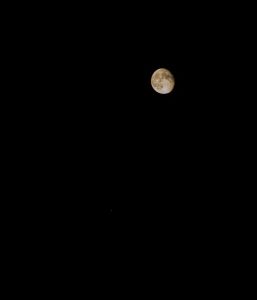
Crescent Nebula by Kevin Langford
A stunning image of the Crescent Nebula taken by member Kevin Langford on the 5th Sept 2023.

”The Crescent Nebula (also known as NGC 6888, Caldwell 27, Sharpless 105) is an emission nebula in the constellation Cygnus, about 5000 light-years away from Earth. It was discovered by William Herschel in 1792. It is formed by the fast stellar wind from the Wolf-Rayet star WR 136 (HD 192163) colliding with and energizing the slower moving wind ejected by the star when it became a red giant around 250,000 to 400,000 years ago. The result of the collision is a shell and two shock waves, one moving outward and one moving inward. The inward moving shock wave heats the stellar wind to X-ray-emitting temperatures.” Ref: https://en.wikipedia.org/wiki/Crescent_Nebula
Details of how Kevin acquired the image are below.
ES 102ED APO, EQ5 Pro
ZWO ASI071, Orion MMAG, L-Enhanced filter
4hrs of exposures
Capture software N.I.N.A and processed using Siril and Affinity Photo
Taken in Bexley, Kent.
Solar Observing at Hall Place & Gardens – Sunday 6th August 2023

NEVER LOOK AT THE SUN DIRECTLY. Please click here for solar observing safely.
Sunday 6th August 2023 – What a glorious day to be out solar observing which is what Crayford Manor House Astronomical Society Dartford (CMHASD) where doing at Hall Place & Gardens in Bexley.
What a busy day it was too! Several telescopes were set up to observe the Sun safely and members of the public were invited to do some solar observing which was readily accepted by many. The Sun put on a good display having several sunspots and prominences for the public to view.
Chairman John Archer wrote ”On Sunday 6th August, the team from CMHASD set ourselves up for the first of our two Solar Observing events at Hall Place & Gardens.
The forecast was for early morning sun, followed by sunny intervals until around 11am, but cloudy conditions until the arrival of rain at 4pm. Given that our timeslot was effectively 11am – 3pm, we were nervous to say the least!
Our pitch was on the grass at the end of the path from the main entrance to the gardens, and we were quite close to the hard standing outside the art gallery and café. With the date being chosen to coincide with the Farmers’ Market, we experienced good foot-fall and our flag was prominent for visitors as they arrived.
At one point we had around a dozen members in attendance and the public were treated to displays of sunspots the like of which we haven’t seen for years. Whilst the big Dob Anita was an immediate attraction, we had Tinie, two solar projectors and a range of H-Alpha and white light filtered scopes with which to demonstrate safe solar observing to a very interested public.
Of particular note was the filtered refractor which Honor had set up with a digital camera attached, affording visitors a proper “live view” of the surface of the sun. Each of the scopes were able to display clear views of sunspots such was their size and quantity. This solar cycle has certainly picked up in terms of activity and although the local forecast was for cloudy conditions, we very much lucked out in terms of clear spells so the public were very fortunate that during the period while the Farmers’ Market was trading, we were able to keep them entertained and educated.
The Crayford team returns again later in August for our second session but there’s no doubt this first visit to Hall Place for Solar Observing in 2023 was a great success.”
Below is an image of the Sun on the 6th August 2023 taken by member Honor Wheeler. The Sun was very active with lots of sunspots. Image acquired using an ED80 Refractor, EQ3 Synscan mount, Canon M6 MarkII, 2x lens Barlow and ISO200/ exp 1/1250s.

CMHASD will be back at Hall Place on Saturday 19th August 2023 to do some more Solar Observing with the public. Please do come and join us!
Thank you to John Archer, Diane Clarke and Honor Wheeler for sharing your photos of the day with us.
Informal Nights at the Society
A few photos showing what members get up to on our ‘informal nights’ at the Society. Activities range from observing, testing/setting up members’ latest equipment purchased, fixing members’ equipment, presentations, general chit chat & banter plus games.
20th July 2023


27th July 2023
Good weather so members took the chance to observe. Dave, Steve & Honor with telescope ‘Tinie’.



Member Honor Wheeler’s image of the Sun through Society telescope ‘Tinie’ fitted with a solar filter – built by members Steve Floodgate & Dave Grist.
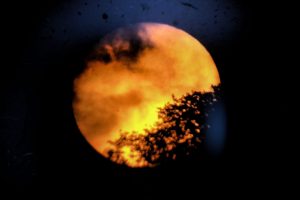

Our Active Sun by Simon Dawes
More stunning images of our active Sun taken by member Simon Dawes in the later half of July 2023. Details of how Simon acquired his images are on the photos.
For more information about the Sun, its structure, atmosphere, sunspots, solar cycle and magnetosphere click on https://solarsystem.nasa.gov/solar-system/sun/in-depth/
12th July 2023

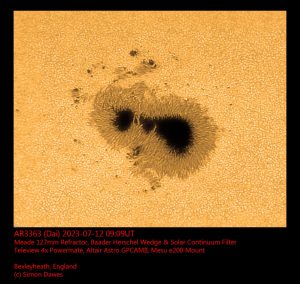
26th July 2023

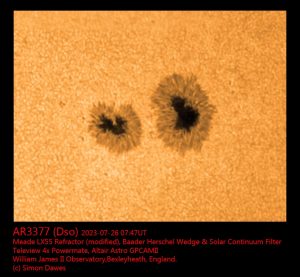


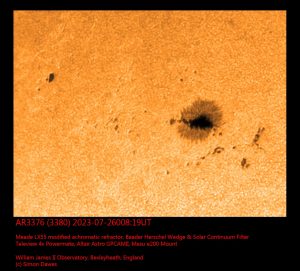

29th July 2023
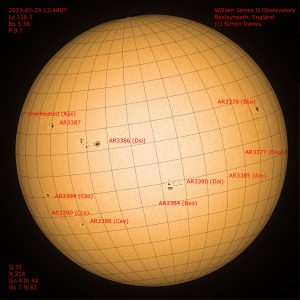


Transit of Qatar-1b by Simon Dawes
More observations for the ExoClock project by Simon Dawes of Qatar-1b in the constellation of Draco taken on the 7th July 2023.

Noctilucent Cloud (NLC) – 5th July 2023
Noctilucent clouds put in a rare appearance on the 5th July 2023 from around 10.50pmish until 11.30pm and a few lucky CMHASD members got to see them 🙂
Below are the photos that members Jim Burchell, Diane Clarke, Martin Crow and Sonia took of the clouds.
Jim’s NLC images, taken with a Pentax KP.


Diane’s NLC image, taken using a Canon M50 Mk2, lens Canon 100mm macro, f3.2 @ 2.5sec, ISO 400.

Martin’s NLC image, taken with an iPhone.

Sonia’s NLC images, taken with an iPhone.


Comet C/2023 E1 (ATLAS) by Dr. Mike Rushton
A rather splendid image of Comet C/2023 E1 (ATLAS) taken by CMHASD trustee and secretary Dr. Mike Rushton on the 12/13th July 2023 in Ursa Minor.
Mike wrote ”This is C/2023 E1 (ATLAS) last night. Approx Mag 14.5 with a greenish coma. The bright star in the image is Mag 7 and the limiting Mag 17.5. Perihelion was 1/7/23 and closest to earth will be on 18/8/23. This was a 20 min exposure with my eVscope.” Imaging started just before midnight on 12/7/23 (23:57 BST).

Comet C/2023 E1 (ATLAS) was spotted on the 1st March 2023 by the NASA funded Asteroid Terrestrial-impact Last Alert System (ATLAS). At the time, the comet was a +19th magnitude object moving through the constellation of Virgo.
On July 1 this Comet ATLAS reached perihelion, its closest approach to the Sun.
To date the comet has now moved into Draco and will move into Cepheus towards its closest approach to Earth mid-August. On August 18 this visitor to the inner Solar System will only be 3 light-minutes or so from our planet.
Based on its inclination to the ecliptic plane (38 degree) and orbital period of about 85 years C/2023 E1 (ATLAS) is considered a Halley-type comet. Though the comet currently has a ‘C’ designation for a long period comet versus periodic comet; that will probably change as 85 years is much less than the 200 year orbital period cut off defining the 2 categories of comet.
Below is the report from SETI/UNISTELLAR Mike received back after submitting his imaging data.
Mike said ”I have had the photometry back and it was brighter than I thought at Mag 12.8. See the report from seti below. The little image in that report is stacked on the moving comet. The original image I sent was stacked on the stars.”
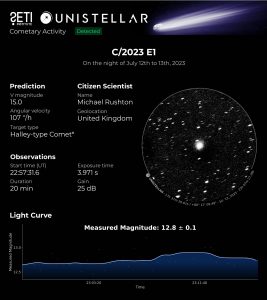
For more information: https://www.space.com/comet-c2023-e1-atlas-little-dipper-how-to-see
The Sun in June 2023 by Simon Dawes
NEVER LOOK AT THE SUN DIRECTLY. Please see our Solar Observing safety page at crayfordmanorastro.com/solar-safety/
Lots of stunning images taken by member and trustee Simon Dawes of our Sun on 4 days during the month of June. Details of how Simon acquired the images are on the photos.
9th June 2023




16th June 2023


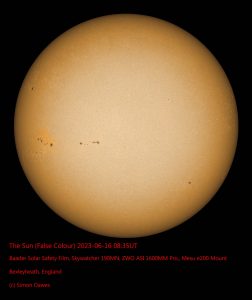

19th June 2023

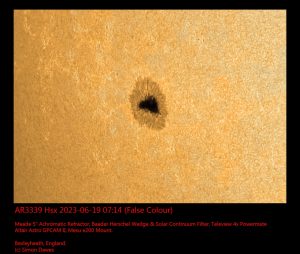




21st June 2023






Noctilucent Cloud – 30th June 2023
Noctilucent cloud spotted on the 30th June 2023 around 3am BST by members Martin Crow and Sonia. Both photos taken using an iPhone.
Martin’s image taken from Essex

Sonia’s image taken from North Kent

Noctilucent Cloud – 25th June 2023
Rare Noctilucent Cloud spotted by CMHASD members Diane Clarke, Martin Crow and Sonia on the 25th June 2023.
First image below was taken by Diane using a Panasonic camera DMC-TZ100, f2.8 @ 1/10sec and ISO 6400 at 11.22pm BST.

The next two images were taken by Sonia using an iPhone 8 at 11.04pm and 11.14pm BST.
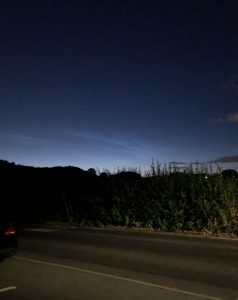
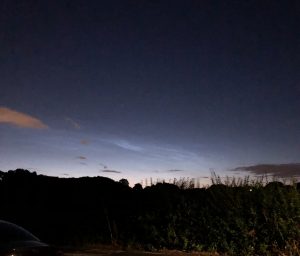
The next image was taken by Martin Crow using an iPhone.

Crescent Moon by Jim Burchell


Crescent Moon & Jupiter by Jim Burchell
A great image of the crescent Moon (with Earthshine) and Jupiter taken on the 14th June 2023 with a Pentax KP 300mm by member Jim Burchell.
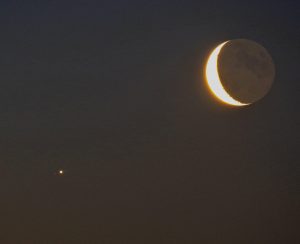
Transit of ExoPlanet HD189733b by Simon Dawes
Another set of observations for the ExoClock project by member Simon Dawes 🙂
Simon wrote ”This was a tricky observation, a bright star with faint comparisons, on the night of the summer solstice – the worst night of the year for astronomy, due to the lack of real night – there were 627 15s exposures which, when processed, works out at about 60Gb of disk space – for a single O-C measurement!”

”This far-off blue planet may look like a friendly haven – but don’t be deceived! Weather here is deadly. The planet’s cobalt blue colour comes from a hazy, blow-torched atmosphere containing clouds laced with glass. Howling winds send the storming glass sideways at 5,400 mph (2km/s), whipping all in a sickening spiral. It’s death by a million cuts on this slasher planet!” Ref:https://exoplanets.nasa.gov/exoplanet-catalog/6876/hd-189733-b/
HD 189733b is an exoplanet approximately 64.5 light-years away in the constellation of Vulpecula. The planet was discovered on October 5, 2005. HD 189733b orbits its host star once every 2.2 days.
The closest transiting hot Jupiter to Earth, scientists have extensively studied the exoplanet’s atmosphere. Researchers have found that the planet has an unusual rain of molten glass.
Full Moon rising – 3rd July 2023 by Jim Burchell
A fantastic collection of images showing the Full Moon also known as the Buck Moon rising on the 3rd July 2023 by member Jim Burchell in the constellation of Sagittarius. All images were taken with a Pentax KP. It was also the 1st Supermoon of 2023.
The full Moon in July is called a Buck Moon after the new antlers that begin to grow from the forehead of a buck (male) deer at this time of year. They shed their antlers in the early spring or late winter, growing full again in July.
This Buck Moon is the first of four Supermoons that will rise this summer 2023 culminating with September’s Full Corn Moon on September 28th.
The Moon orbits the Earth in an elliptical shape rather than in a circle, so its distance to us (Earth) varies over time; so there are times in the Moon’s orbit when it is closer to the Earth and other times when it is further away. A Supermoon is a phenomenon that occurs when a full Moon takes place at the same time as the perigee; when the Moon is closest to the Earth.
A Supermoon is actually classified when a full Moon is closer than 360,000km to the Earth. This distance is around 21,000km closer than the Moon’s average distance from us of around 384,400km.
The Old Farmer’s Almanac which has published astronomical data for many centuries, says the Buck Moon would orbit closer to the Earth than any of the full Moons we have already had this year.
The end of August’s full Moon will be the only supermoon closer to the Earth this year, the publication said.
Below are Jim’s photos…..
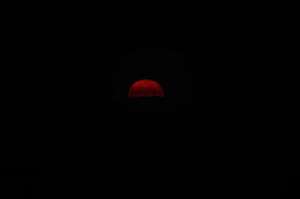





Note that 2024 will have four full Supermoons in a row too. They will occur on August 19, September 18, October 17 and November 15.
The Sun – 7th July 2023
NEVER LOOK AT THE SUN DIRECTLY. Please see our Solar Observing safety page at crayfordmanorastro.com/solar-safety/
CMHASD members Jim Burchell, Honor Wheeler and Simon Dawes took the opportunity to observe and image the Sun on Friday 7th July 2023 and below are their super images.
The Sun is very active with many sunspots and one so large it was seen from Mars; yes that is correct – from Mars.
The very large sunspot AR3363 which has just emerged over the Sun’s southeastern limb was spotted by the Mars rover Perseverance several days before we did. On July 2nd, the rover’s mast-mounted stereo camera MASTCAM-Z tilted up to the sky above Jezaro crater and photographed a deep-black dot on the solar disk. For more information about this; see https://www.spaceweather.com/archive.php?view=1&day=07&month=07&year=2023.
Jim Burchell

Honor Wheeler
The Sun in Hydrogen Alpha.
Composite of 2 photos one for the disc and one for prominences details, then layered in Snapseed.
Canon M6 Mark II, Coronado PST,
EQ3 Synscan mount, x2 Barlow
ISO200, 1/25s
2023.07.07 12:48UT

Image enhanced to show some of the Sun’s prominences.

Solar Sunpsots in White light
Canon M6 Mark II, 80mm Refractor, EQ3 Synscan mount, Baader Solar filter, x2 Barlow.
ISO100, 1/800s.
2023.07.07 12:31UT
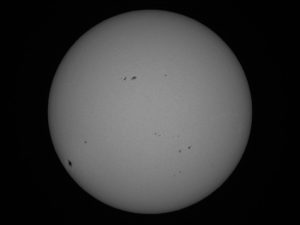
Sunspot AR3363 appearing over the southeastern limb of the Sun.
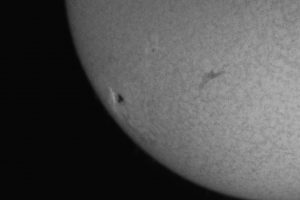
Simon Dawes
Details of how Simon acquired his images are on the photos.



Sun full disk in White light – 12 active regions. Q=30 and R = 225 so pretty active today. Click here to see a full version https://britastro.org/observations/observation.php?id=20230707_113215_4d5fba6e58719cdf

For the latest information about the Sun’s activity check out Spaceweather.com
CMHASD Informal/Observing Evening – 6th July 2023
Thursday 6th July was an informal night at the pavilion and some members took the opportunity to do some observing using Honor’s PST to observe the Sun & Jo’s Newtonian to observe Venus. Thankyou to Chairman John Archer and to Diane Clarke for sharing your photos of the evening.


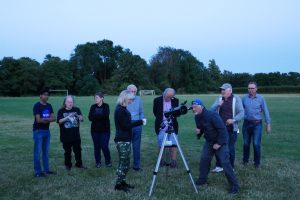



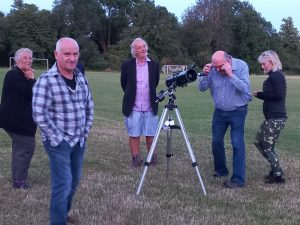
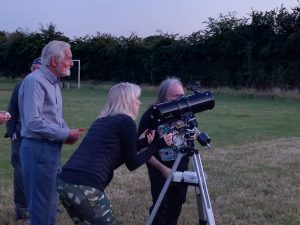
Venus and a Crescent Moon by members Jim Burchell & Gary Hunt
Look towards the West after sunset for a splendid view of Venus and the crescent Moon over the next few evenings.
Members Jim Burchell and Gary Hunt did yesterday evening the 21st May 2023 and captured these great images of a young crescent Moon with Venus.
Moon & Venus by Jim Burchell

Moon & Venus by Gary Hunt

The Sun – May 2023
NEVER LOOK AT THE SUN DIRECTLY. Please see our Solar Observing safety page at crayfordmanorastro.com/solar-safety/
The latest images of our active Sun by members Simon Dawes and Jim Burchell.
Simon’s 3 images below were taken on the 18th May 2023. Details of how Simon acquired the images are on the photos.



Jim’s image was taken on the 21st May 2023

29 hour old Moon by John Howarth – 20th May 2023
A lovely photo of a young Moon in the constellation Taurus taken by CMHASD trustee John Howarth on the 20th May 2023.
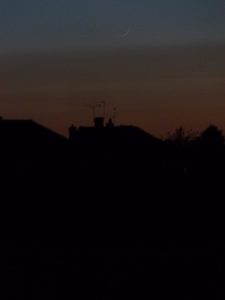
Venus, Mars and the Twins by Simon Dawes and Jim Burchell
Two great images below of the planets Mars and Venus with the twins Castor & Pollux. Castor and Pollux are the 2 brightest stars in the constellation of Gemini.
Left to right: Mars, Pollux & Castor all nicely lined up with Venus lower right captured by member Simon Dawes on the 16th May 2023.

Below; moving again from left to right: Mars, Pollux & Castor with Venus lower right captured by member Jim Burchell on the 21st May 2023.
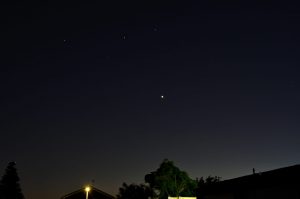
Exoplanet HAT-P-12b
Another set of transit observations for the ExoClock project by Simon Dawes of Exoplanet HAT-P-12b.
HAT-P-12b is 468 light years away from Earth, orbiting a 13th magnitude K-type star in the constellation Canes Venatici. It is was discovered by the HATNet Project on April 29, 2009.

Sunset & Full Moon Rising by Jim & Honor – 5th May 2023
A collection of beautiful images of our Sun setting and a full Moon rising on the 5th May 2023 taken by members Jim Burchell & Honor Wheeler.
Sun with Sunspot setting by Honor

Sunset by Jim

”The Full Moon of May is known as Flower Moon to signify the flowers that bloom during this month. Native Americans called it Budding Moon, Egg Laying Moon, and Planting Moon.
The Anglo-Saxon name for May’s brightest Moon phase is Milk Moon from the Old English Rimilcemona. It means three-milkings-month in modern English because cows were milked three times a day during this time of year. The Celtic and Old English names are Mothers’ Moon, Bright Moon, Hare Moon, and Grass Moon.” ref:https://www.timeanddate.com/astronomy/moon/flower.html
Flower Moon on 5th May by Honor

FLower Moon rising by Jim
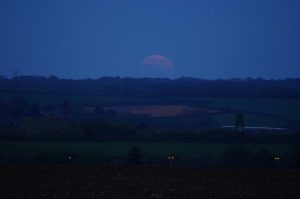

The Sun by Simon Dawes – 10th & 16th May 2023
NEVER LOOK AT THE SUN DIRECTLY. Please see our Solar Observing safety page at crayfordmanorastro.com/solar-safety/
A fantastic collection of images of our Sun taken by Simon Dawes on the 10th & 16th May 2023 from North Kent, showing lots of sunspots 🙂
Details of how Simon acquired his images are on the photos.
The Sun on the 16th May 2023


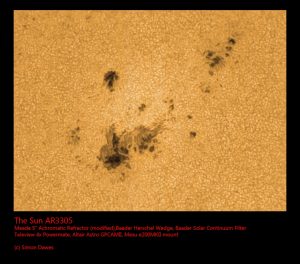
The Sun on the 10th May 2023





Fogbow by Kevin Smith – 7th May 2023
A great example of a fogbow captured by member Kevin Smith on the 7th May 2023.
A fogbow is a similar phenomenon to a rainbow but as its name suggests, it appears as a bow in fog rather than rain.
Due to the very small size of the water droplets that cause fog being so much smaller than in rain i.e. smaller than 0.1 mm in diameter; fogbows have very weak colours or no colour at all. Fogbows that have no colour are sometimes called ‘white rainbows’.

A Fog Bow by Kevin Smith
”How do fogbows form?
The elements that make up a fogbow are the same as for a rainbow – sunlight at the observers back, and water droplets in front. The water droplets that make up fog are so tiny compared to raindrops, between 10 and 1000 times smaller, that while the light still reflects from the water droplet back towards the observer, the process of diffraction of the light by the droplet becomes a dominant effect.
The process of diffraction broadens the reflected beam of light which smears out the colours which give the characteristic ghostly white, or very faintly coloured fogbow. This also makes the fogbow much broader than a rainbow.
The fog bank has to be relatively diffused and thin to allow the light to pass through the droplets and create the effect. Fogbows are large, almost as big as rainbows.
A similar effect can also be seen from aircraft in cloud droplets, when they’re known as cloud bows.” ref:https://www.metoffice.gov.uk/weather/learn-about/weather/optical-effects/rainbows/fogbow
Sun Halo by John Archer – 30th April 2023
NEVER LOOK AT THE SUN DIRECTLY. Please see our Solar Observing safety page at crayfordmanorastro.com/solar-safety/
A splendid example of a Sun halo captured by CMHASD Chairman John Archer on the 30th April 2023.
A Sun halo is caused by the refraction, reflection, and dispersion of light through ice particles suspended within thin, wispy, high altitude cirrus or cirrostratus clouds.


Hot off the Press!!!!! member Kevin Langford’s Pleiades image and BBC Sky at Night

Check this out – our member Kevin Langford’s brilliant Pleiades (M45) image – see above; being used on the BBC Sky at Night website. Plus Kevin’s image was shown in the programme aired on the 16th May 2023 too!………Well Done Kevin 🙂
CMHASD at the BAA Winchester Weekend 14-16th of April 2023.
CMHASD at the BAA Winchester Weekend 2023
Written by member Honor Wheeler
The weekend started off with the majority of us meeting up at a pub for Friday lunch, although the M25 did its best to make that as difficult as possible but thankfully we all made it in the end. Then an A31 closure sent us all on a long, picturesque diversion before finally checking in at the Sparsholt College campus.
The first lecture on the Friday night, after a delicious dinner of course, was titled ‘Superluminous Supernovae: Fantastic bursts and where to find them’ by Dr Matt Nichol, Queen’s University Belfast which was an fascinating talk on Supernovae past and present. This was followed by a trip to the campus pub for some or returning to the common room for a chance of some relaxation for others.


The Crayford Crew
A busy lecture Saturday followed starting with ‘Pete & Paul’s 2023 Astronomical Challenges’ followed by ‘OJ287 – a Black Hole Worthy of Amateur Study’ by Gary Poyner BAA, ‘the Electromagnetic Spectrum’ by Paul Hearn BAA, a talk from Dr Alex Cameron on the ‘JWST Observing Galaxies in the Very Early Universe’ looking even further back in time to 13.1 Billion years and seeing one of the highest Redshifted Galaxies to date.
Before the afternoon lectures recommenced, a little Solar observing was achieved with some observations of complex groups of Prominences and Sunspots.


The Sun by Honor Wheeler
The afternoon session was presented by the BAA Mercury and Venus section starting with a look at the ‘Sodium Ion Tail of Mercury’ by Chris Hooker and how to image this elusive ‘Comet like’ tail followed by ‘Observing Venus in IR and UV’ in a variety of short talks by other members of the section.
Some members took the opportunity to explore the college grounds which are extensive and enjoyed some great views of the countryside seeing Deer, Buzzards and a rather stunning bird of prey known as a Red Kite.

Saturday evening and we enjoyed the Alfred Curtis Lecture, ‘Exploring the Ice Giants of our Solar System’ by Prof. Patrick Irwin (University of Oxford) another interesting lecture which left us with the hope that maybe we’ll be visiting these enigmatic Planets sooner rather than later.
A few members then made the most of clear skies and carried out observations of Venus and its conjunction with the Hyades before retiring to the pub or the common room for discussions about the day’s lectures.

The Hyades & Venus by Jim Burchell
On Sunday the day began with an intriguing lecture ‘How Astronomers Can Save The World’ by Stuart Eves (SJE Space) but I don’t think we were quite convinced that painting an Asteroid with White Paint would save the world from an impending impact (Steve was just kidding!!)
Dr Jen Gupta followed with a lively discussion on seeing ‘The Invisible Universe’ and looking at how we see through the dust obscuring distant, new stars.
‘Let There Be Light’ followed with an extensive tour of our local star the Sun by Dr Matthew Malek.
After lunch came the Members session and the opportunity to hear about projects, imaging and observations undertaken by members but which also included a rather different lecture which brought a lighter side to the proceedings.
Steve Floodgate & Dave Grist gave us a Stella (Artois) Performance…I mean Lecture on the complex Crayford Astronomical Society’s ‘The Book’. You had to be there but safe to say the Members session was one everyone will remember until the end of time…! And maybe there will be a Pub at the end of time too…?


And thus the weekend was over leaving us all heavy with the knowledge gleaned from eminent Doctors, Professors and experts in their field and also filled with an amount of excellent food we just couldn’t say no too.
In the end 15 members of the society managed to attend the weekend, with 2 other members who unfortunately had to cancel due to personal reasons.
Overall a thoroughly enjoyable and informative weekend with lots of information to mull over and I’m sure leading to numerous further discussions to be had until next year’s BAA Winchester weekend 2024.
The BAA Winchester Programme 2023 is a downloadable and printable as a PDF here: https://britastro.org/wp-content/uploads/2023/04/Winchester-programme-card-2023.pdf
Thankyou to Honor, Jim and Simon for sharing your photos of the weekend.
Ceres photobombing Messier 100 by Simon Dawes – 26th March 2023
On the night of the 26th/27th March 2023 Ceres appeared to ‘meet’ and pass directly in front of the beautiful spiral galaxy Messier 100 (M100) and for a few hours Ceres looked like a brilliant supernova beaming from one of the M100 galaxy’s arms.
At the time of the line-of-sight view, Ceres was shining from a piddling distance of 150 million miles (240 million kilometers) from Earth whilst the galaxy at 56 million light-years away; so actually trillions of miles apart! The ‘meeting’ took place in the constellation Coma Berenices just a few days after Ceres’ opposition, which is when Earth passes between it and the Sun.
Despite the poor weather CMHASD Trustee & member Simon Dawes managed to capture the event – see his image below 🙂 Ceres is identified with 2 red lines and M100 is at the 4 O’clock position from Ceres.
Ceres is a dwarf planet and the largest asteroid in the main asteroid belt that is between Mars & Jupiter. It was the first asteroid to be discovered on the 1st January 1801 and was classified as 1 Ceres in 1851. Ceres was designated a dwarf planet, a new category of solar system objects defined in August 2006 by the International Astronomical Union.
Ceres’s small size; about 14 times smaller than Pluto means that even at its brightest, it is too dim to be seen by the naked eye, except under extremely dark skies. Its apparent magnitude ranges from 6.7 to 9.3, peaking at opposition.
Messier 100 (also known as NGC 4321) is a face-on, spiral galaxy with an apparent magnitude of 9.3. It is one of the brightest and largest galaxies with a diameter of 160,000 light years. It was discovered in 1781.
Information of how Simon acquired his image is on his photo and for more information about this event see https://skyandtelescope.org/astronomy-news/observing-news/tell-time-with-the-big-dipper-see-ceres-transit-m100/#:~:text=By%20good%20fortune%20Ceres%20will%20pass%20directly%20in,northern%20portion%20of%20the%20Virgo%20Cluster%20this%20spring.

Waxing Gibbous Moon by Neil Webster
A lovely image of a waxing gibbous Moon taken on the 29th April 2023 by member Neil Webster.

To see a higher resolution photo of Neil’s image – check out his flickr page at https://www.flickr.com/photos/137388222@N05/52861969736/.
The Sun – 29th April 2023 by Jim Burchell

Venus & Mercury – 13th April 2023 by Diane Clarke.
Our rocky neighbours; Venus & Mercury taken by member Diane Clarke whilst at the pavilion on the 13th April 2023.

Venus & Pleiades by Jim Burchell – 10th April 2023
”The Pleiades are also known as The Seven Sisters, Messier 45 and other names by different cultures, is an asterism and an open star cluster containing middle-aged, hot B-type stars in the north-west of the constellation Taurus. At a distance of about 444 light years, it is among the nearest star clusters to Earth. It is the nearest Messier object to Earth, and is the most obvious cluster to the naked eye in the night sky. The cluster is dominated by hot blue luminous stars that have formed within the last 100 million years.” ref:https://en.wikipedia.org/wiki/Pleiades

Mercury & Venus – 4th April 2023
Hot off the press – all taken last night 4th April 2023.
Venus & Mercury by Jim Burchell

Mercury by Jim Burchell

Mercury by Martin Crow taken with an iPhone.

Mercury & Venus by Jim Burchell – 3rd April 2023
Two superb images taken by member Jim Burchell of the planet Mercury and then of the planets Mercury & Venus on the 3rd April 2023.


Crescent Moon and Venus – 24th March 2023
Two lovely images of a crescent Moon, with Earthshine and Venus taken by member Jim Burchell on the 24th March 2023. The first image has the ISS in it too!

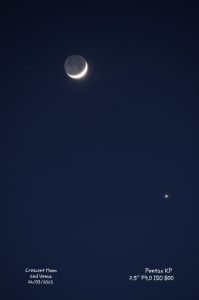
Full Worm Moon – 7th March 2023 by Jim Burchell & Honor Wheeler
A selection of super images of the Full Moon taken on the 7th March 2023.
”In March, the Full Moon is the Worm Moon. It is also called Lenten Moon, Crow Moon, Crust Moon, Chaste Moon, Sugar Moon, and Sap Moon. The Worm Moon gets its name from the earthworms that come out when the soil warms up. The worms provide food for birds and other animals. It happens around the changing of the seasons, from astronomical winter to spring in the Northern Hemisphere.” ref https://www.timeanddate.com/astronomy/moon/worm.html
This stunning very atmospheric image of the Full Worm Moon was taken by member Jim Burchell.

The next 3 beautiful images showing the Full Worm Moon rising were taken by member Honor Wheeler. Honor said ”Full Moonrise was not easy to capture tonight. The Moon barely escaped the cloud but got a few pics nonetheless.” and yes she did 🙂
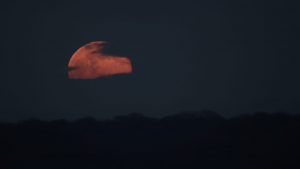


Images by Jim Burchell – 23rd to 25th Feb 2023
Member Jim Burchell was busy out and about towards the end of February photographing our stunning sky and below is a selection of his superb images.
Orion, Taurus and the Pleiades taken on the 23rd Feb from the CMHASD pavilion, Sutton-at-Hone.
Image was taken with a Pentax KP on a static tripod, F6.3, 30 sec, 18 MM and iso 800.

Crescent Moon on the 24th Feb.

The Sun taken on the 24th Feb.
NEVER LOOK AT THE SUN DIRECTLY. Please see our Solar Observing safety page at crayfordmanorastro.com/solar-safety/

Crescent Moon with Jupiter & Venus on the 25th Feb.
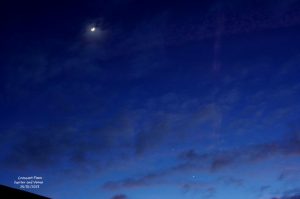
Asteroid 2023 CX1 caught by CMHASD meteor camera on Monday 13th February 2023
Updated: 19th February 2023
Exciting news!!!!!! An asteroid that had only been discovered in space a few hours before impacting the Earth has been caught by the Crayford (CMHASD) meteor camera on Monday 13th February 2023 at 2.59am.
It is only the seventh time an asteroid strike had been successfully forecast, in what the European Space Agency said was ‘a sign of the rapid advancements in global asteroid detection capabilities’.
Despite all the cloud that was around at the time; our meteor camera managed to capture the small 1 meter asteroid now called 2023 CX1 as it entered the Earth’s atmosphere creating a brilliant fireball as it disintegrated, lighting up the night sky over the English Channel as it travelled eastward over the coast of Normandy, France. The 3ft meteoroid created an ‘airburst’ that could be seen across southern England and Wales and in parts of northern France as far south as Paris.
Below is the CMHASD meteor camera video showing the fireball.
The one-metre asteroid was discovered by Krisztián Sárneczky with the 60-cm Schmidt telescope of the Piszkéstető Observatory in Hungary. It is his second discovery of an impactor,
‘’The fireball event happened at the predicted time (02:59 UTC) and location, with observations mostly from Southern UK and France, but also from Belgium, the Netherlands and even Germany. It is likely that some fragments of the meteoroid may have survived the atmospheric pass and fell somewhere onshore close to the coast north of Rouen, in Normandy, France’’ ref: https://neo.ssa.esa.int/-/new-imminent-impactor-found-by-european-astronomer
Now a space rock (meteorite) from that fireball has been found in northern France and CMHASD are absolutely thrilled. On 15 February 2023 art student Loïs Leblanc found the first meteorite of 2023 CX1 in a field located in Saint-Pierre-le-Viger.
Update on Asteroid 2023 CX1 aka SAR2667 – YouTube
https://en.wikipedia.org/wiki/2023_CX1
More news still to follow – so do check back.
Comet C/2022 E3 (ZTF) by George Buckberry – 14th Feb 2023
The latest image of the Green Comet C/2022 E3 (ZTF) that is currently gracing our skies by member George Buckberry. The photo was taken on the 14th February 2023 by George.
”Having spent months climbing up out of Corona Borealis and drifting past the Big and Little Dippers, like a rollercoaster car reaching its highest point, Comet C/2022 E3 ZTF has now gone ‘over the top’ of its path across the northern sky and is falling south, fading in brightness and shrinking in size as it drops towards Taurus. For northern hemisphere comet chasers and skywatchers E3’s show is almost over.” ref https://www.skyatnightmagazine.com/advice/comet-c-2022-e3-ztf/
So well done George for capturing the Comet, you did well to get it as it’s fading fast!

George has written on the image below of how he acquired the photo and the location of the star Aldebaran to the comet. Aldebaran (Alpha Tauri) is a bright red giant star in the constellation of Taurus.

Collinder 26 by Simon Dawes – 14th February 2023
Super image of Collinder 26 – the heart of the Heart Nebula (IC1805) in the constellation Cassiopeia; aptly taken by member and trustee Simon Dawes on the 14th February 2023.
The Heart Nebula’s intense red output and its form are driven by the radiation emanating from a small group of stars near the nebula’s center. This open cluster of stars, known as Collinder 26 or Melotte 15, contains some stars that are 50 times the mass of our Sun.
The Collinder catalogue is a catalogue of 471 open clusters compiled by Swedish astronomer Per Collinder.
Details of how Simon obtained the image are on the photo.

The California Nebula (NGC1499) by Neil Webster
The California Nebula is an emission nebula located in the constellation Perseus not far from the Pleiades and near the star Xi Persei. The nebula’s signature reddish glow is thanks to this nearby star, Xi Persei, which is on the top, left side of the nebula in this image. This luminous blue star (also known as Menkib) is a blue giant that is over 12,000 times brighter than the sun. This massive star ionizes the hydrogen atoms in the California Nebula and is responsible for creating this iconic deep sky object.
The Nebula was discovered by E. E. Barnard in 1884 and its name comes from its resemblance to the shape of the US State of California. It is almost 2.5° long in the sky and roughly 1,500 light-years away from Earth.
Neil acquired the image using a WOGT71, EQ6 R, ZWO294MC, Optolong LEnhance filter, Astro Essentials 50mm Guide Scope, ZWO 290MM.
50x240s Subs, 12xDarks, 40xFlats/Bias.
Processed using APT, PHD, Nebulosity, Photoshop (Camera Raw), Gradient XTerminator.

Check out Neil’s Flickr page at https://www.flickr.com/photos/137388222@N05/
Comet C/2022 E3 (ZTF) by Martin Crow
Member and trustee Martin Crow captured the Comet C/2022 E3 (ZTF) on the morning of the 18th January 2023 at 03:20am. The ion tail of the comet can be seen emerging at around the 2 o’clock angle in the photos.


Beautiful Snow Moon by Jim Burchell
On the 5th February 2023, member Jim Burchell captured this absolutely beautiful image of the full moon also known as the Snow Moon. Jim took the photo using a Pentax KP, 300 mm, F7.1 1/25 sec and iso 400.

Active Sun – 10th February 2023 by Jim Burchell
NEVER LOOK AT THE SUN DIRECTLY. Please see our Solar Observing safety page at crayfordmanorastro.com/solar-safety/
A super image of an active Sun captured by member Jim Burchell on the 10th February 2023 showing Sunspots 3213 to 3221. Jim took the image with a Pentax KP attached to 102mm Altair Astro refractor using a solar filter.

Below is an image of the Sun on the 10th Feb 2023 taken from Spaceweather com showing the sunspots with their allocated numbers. Credit: SDO/HMI




